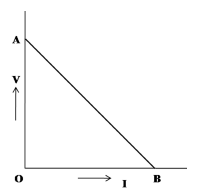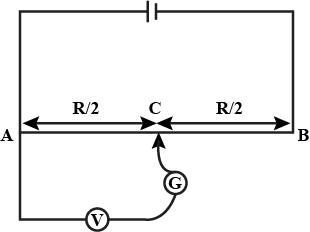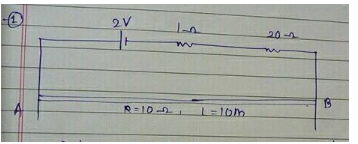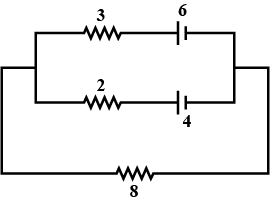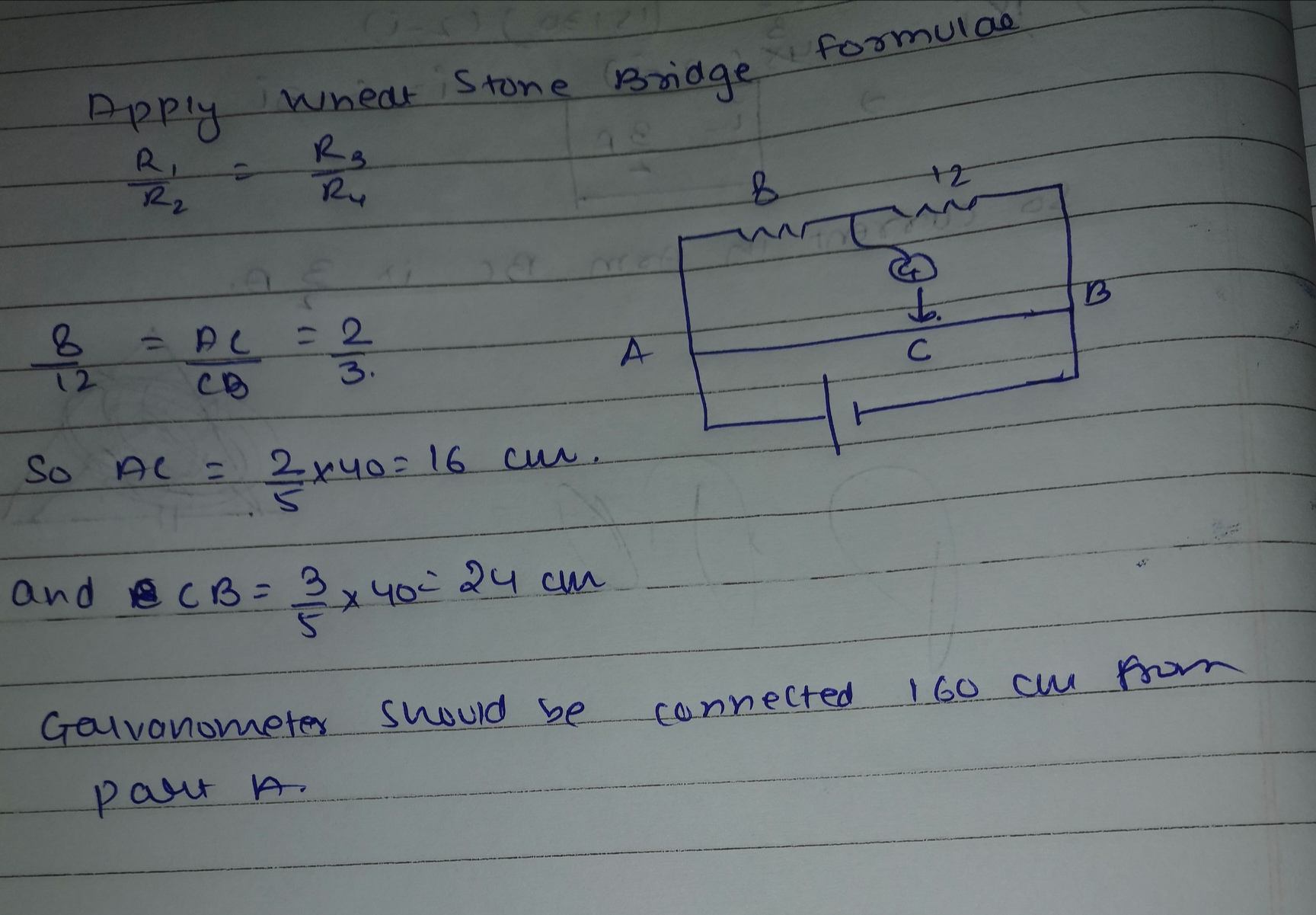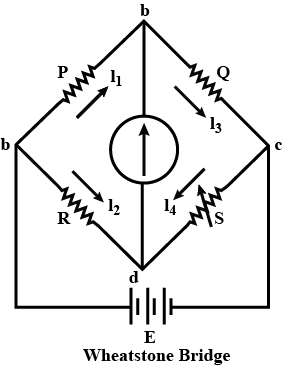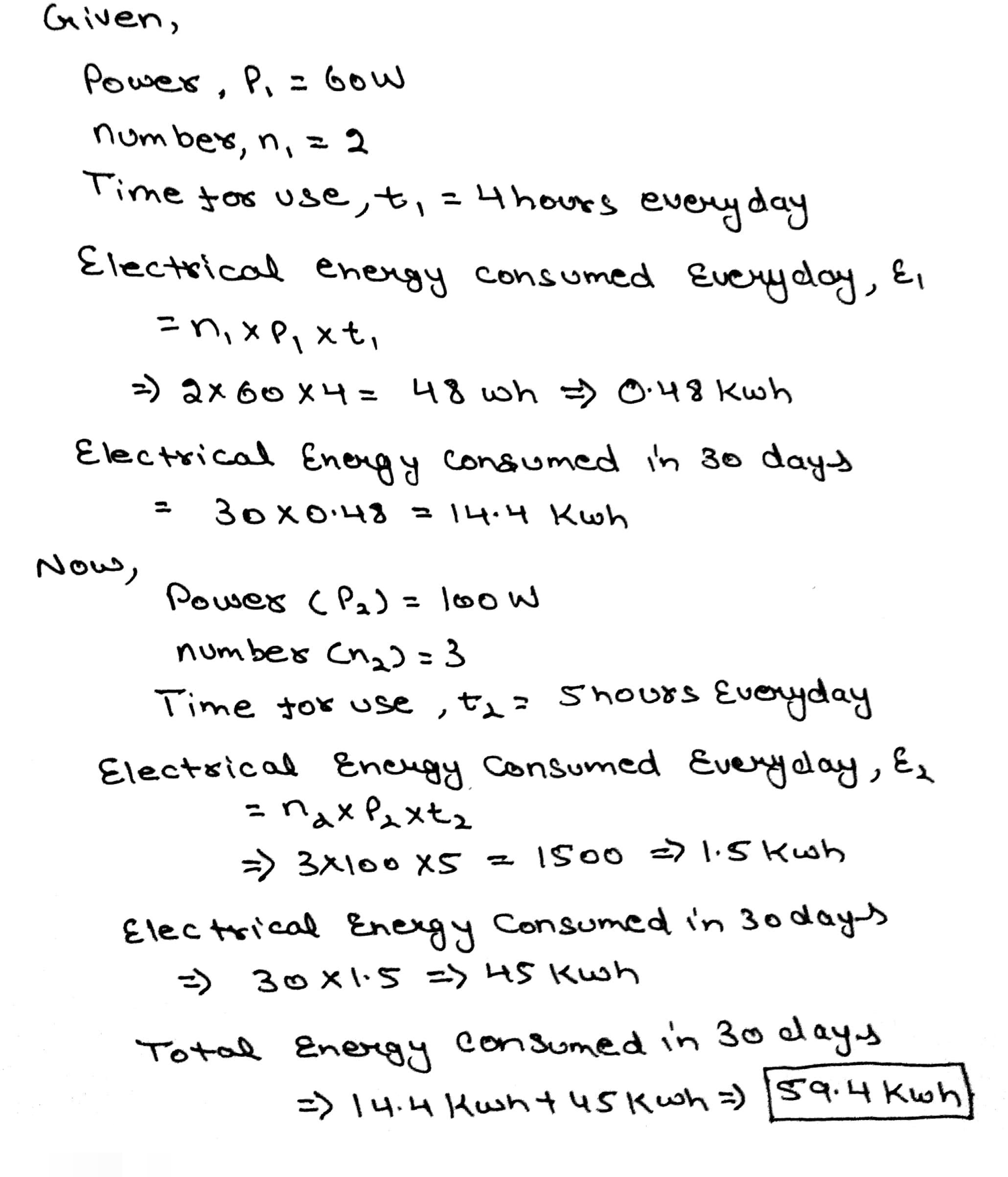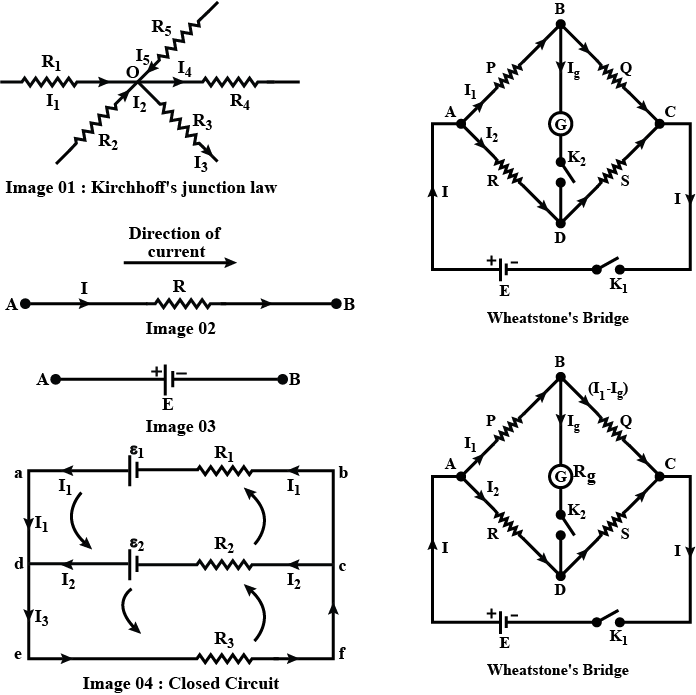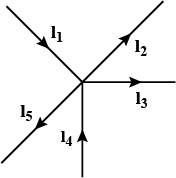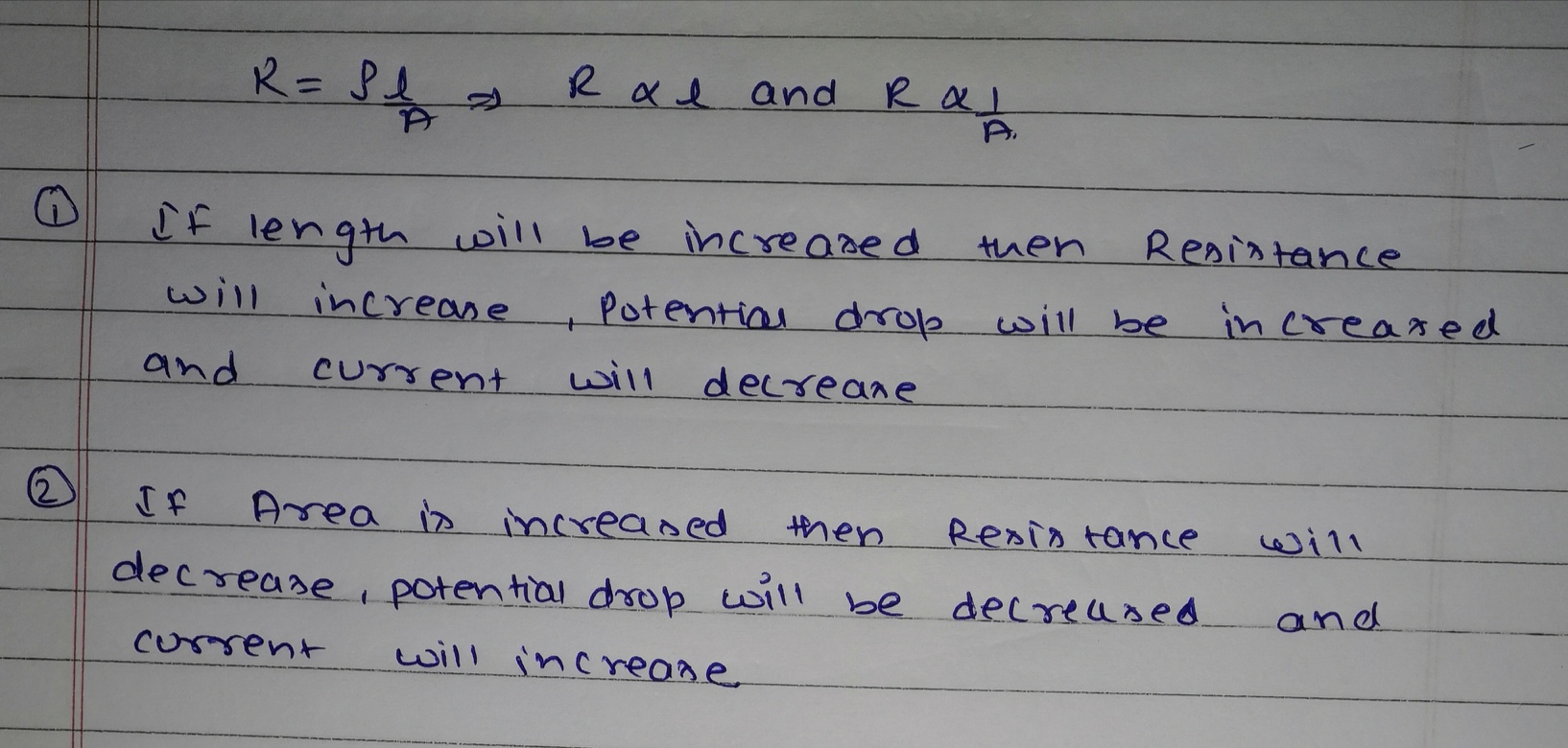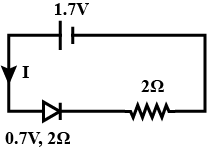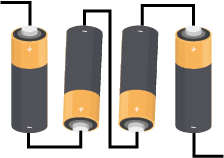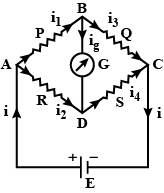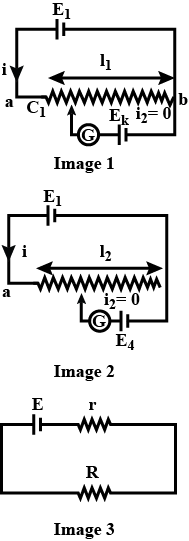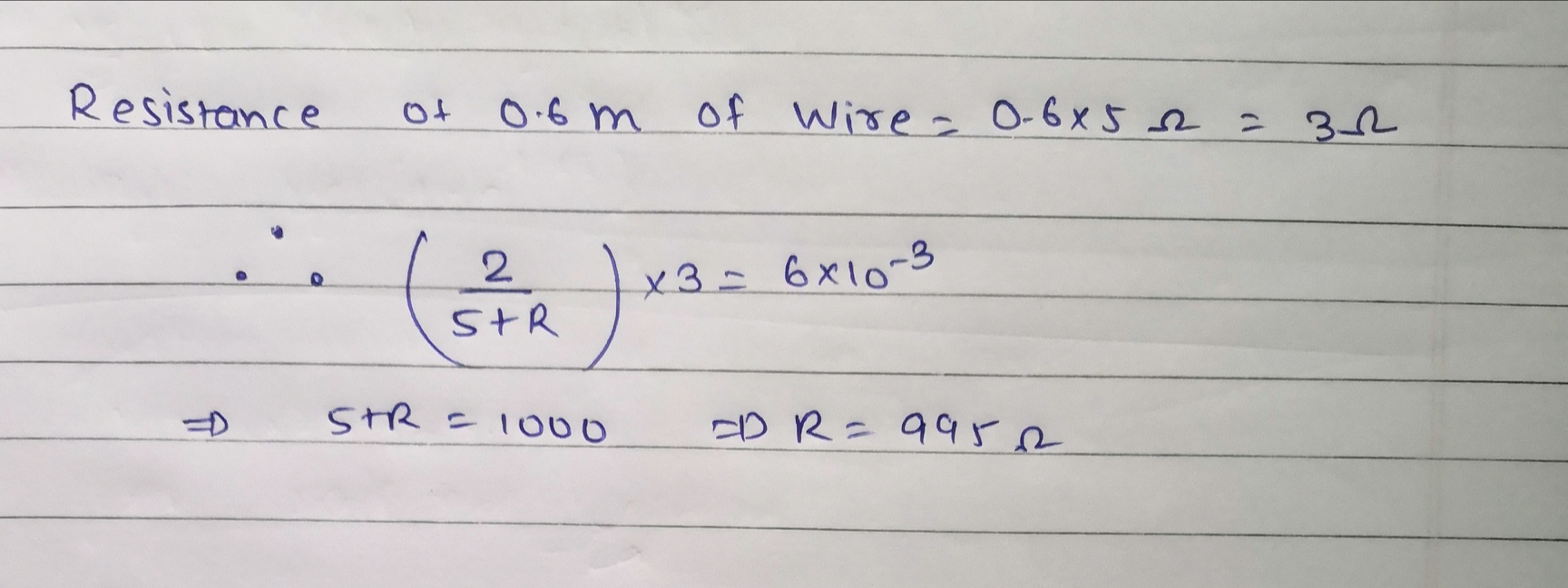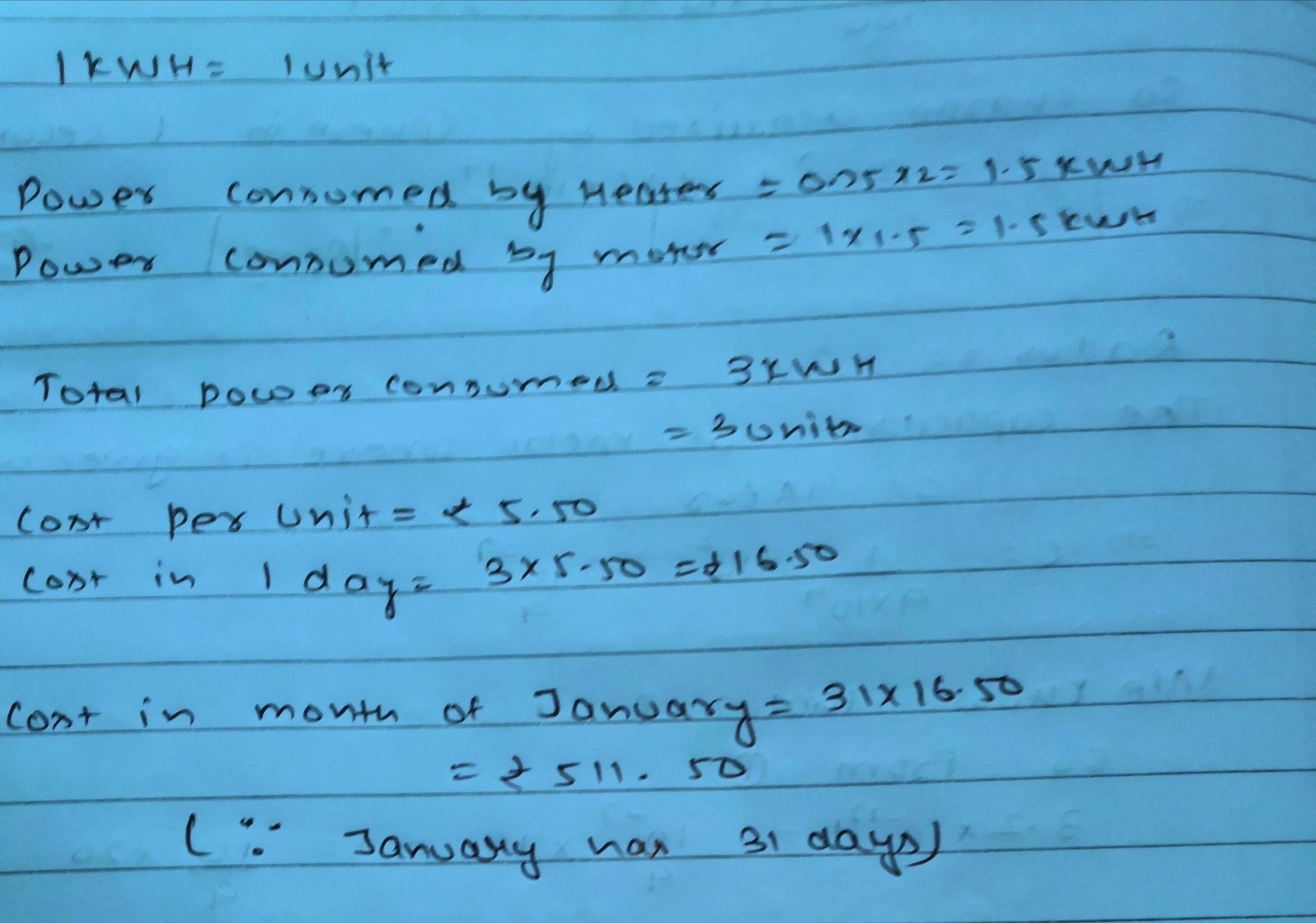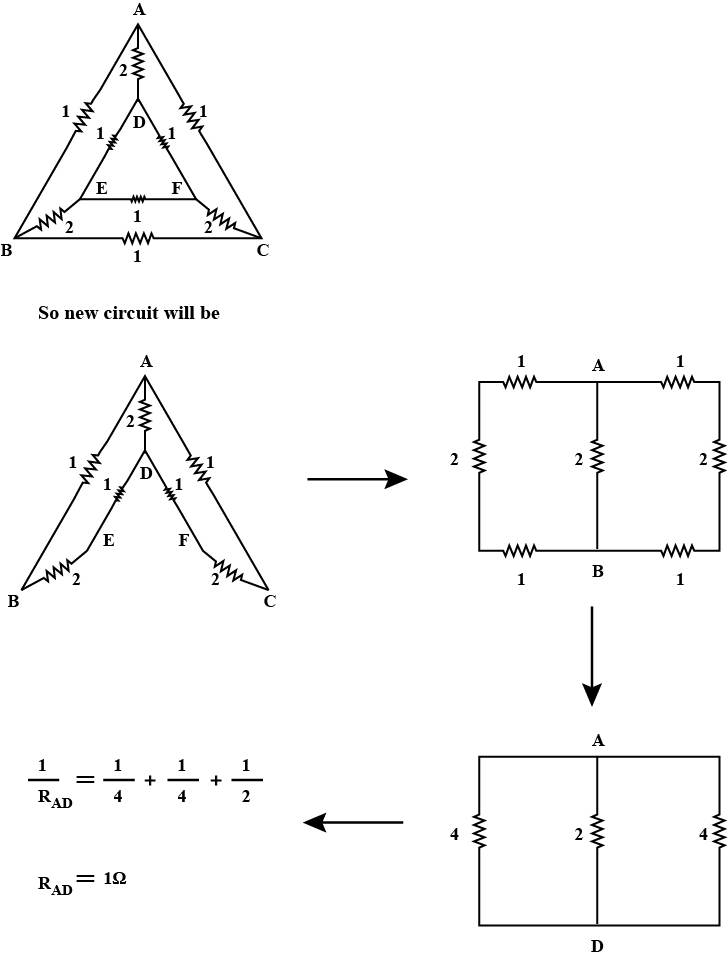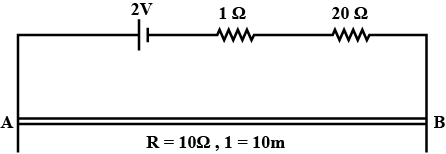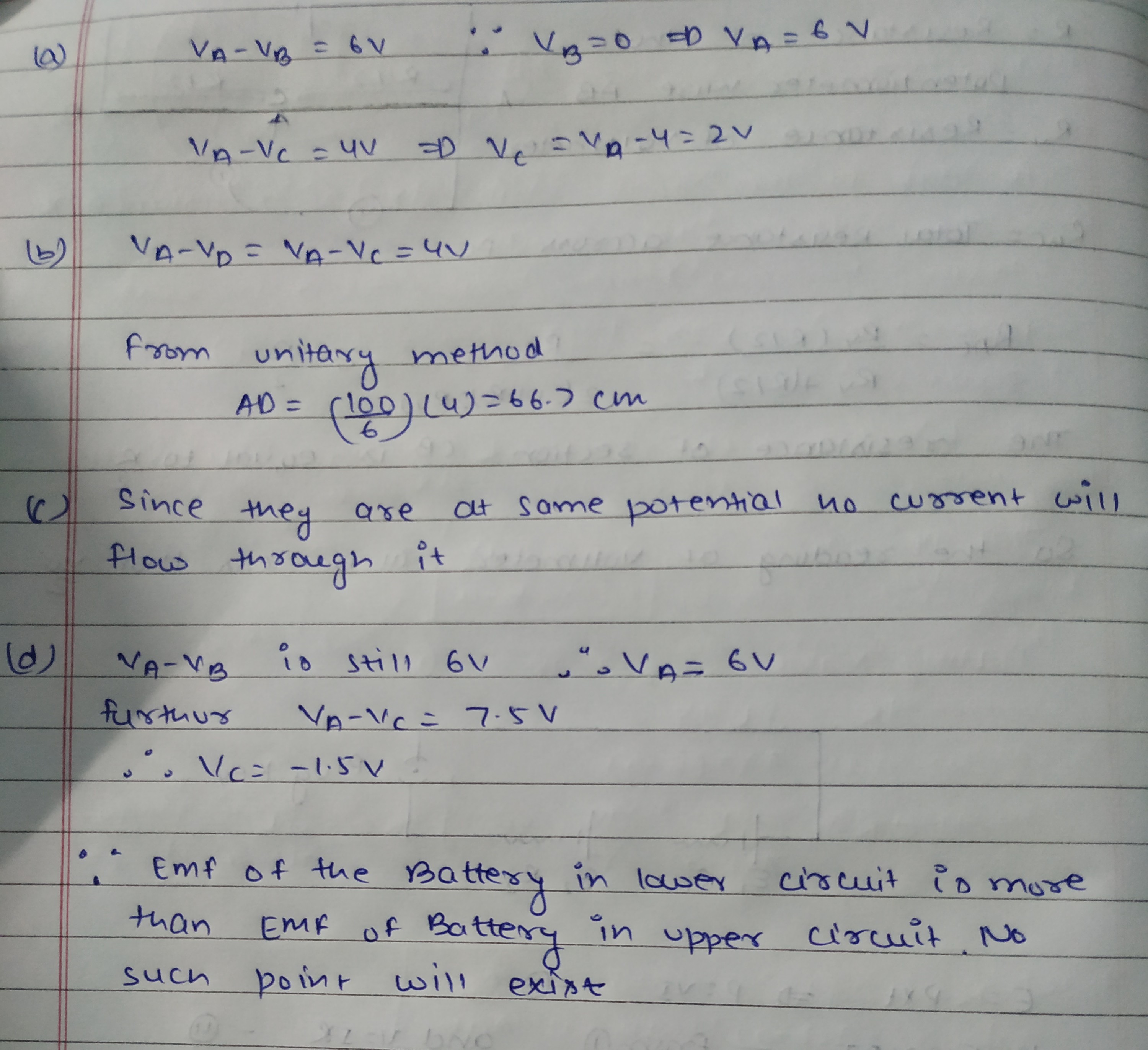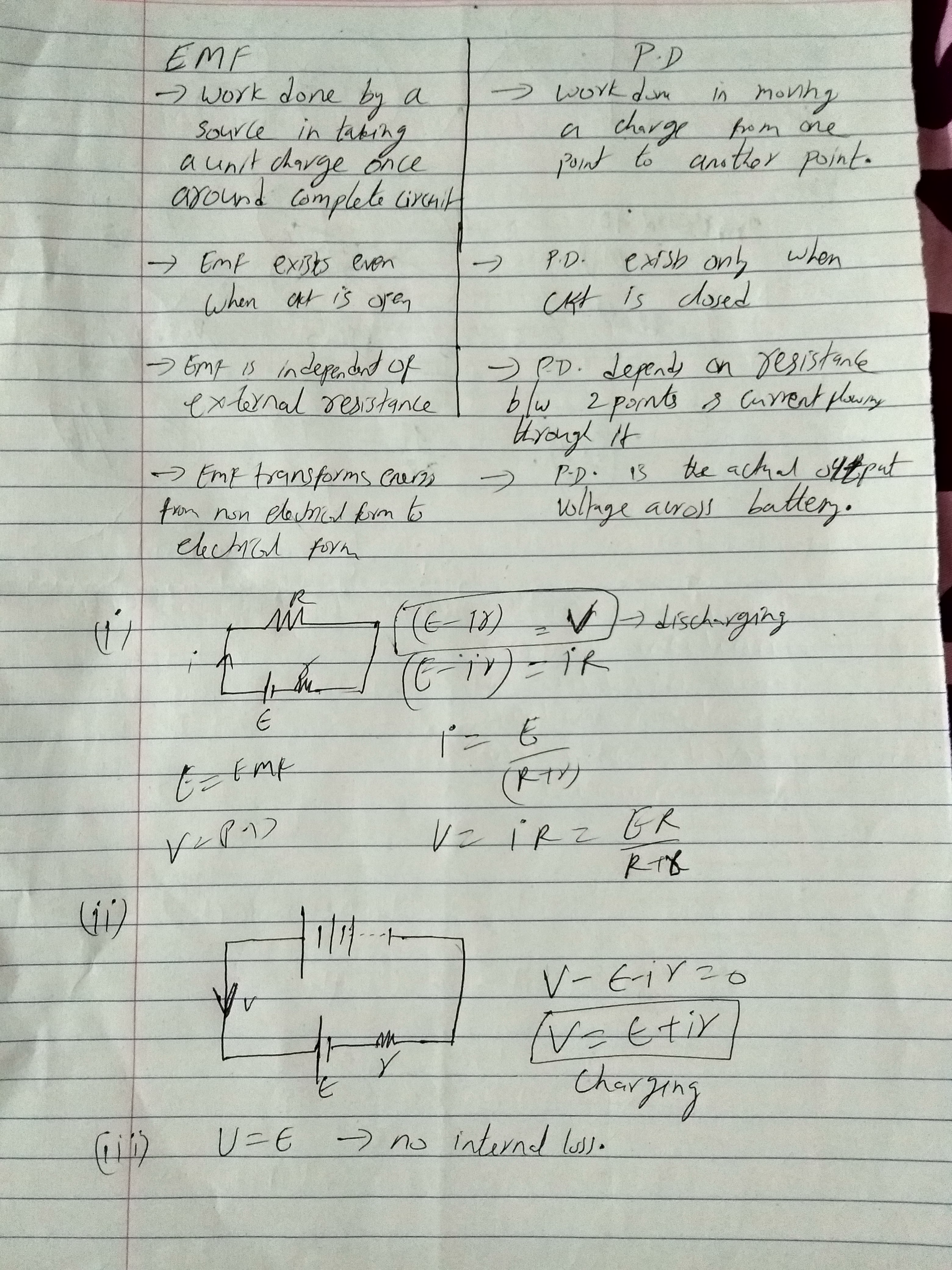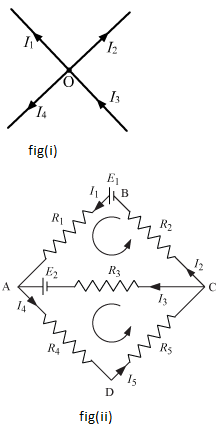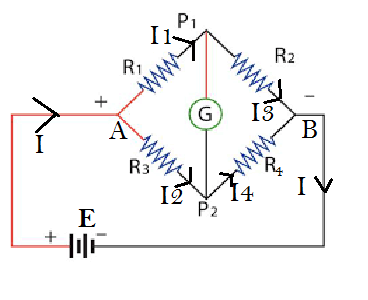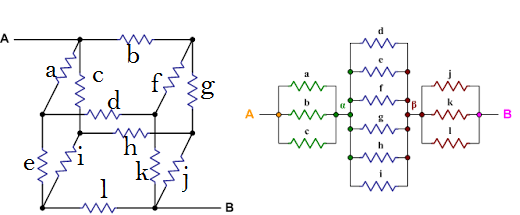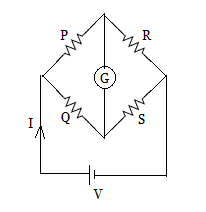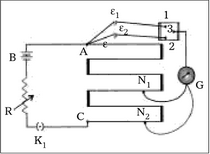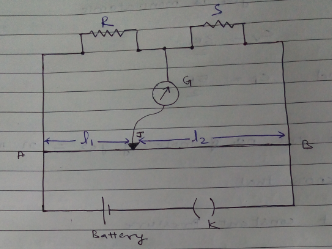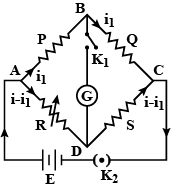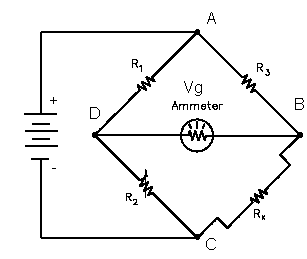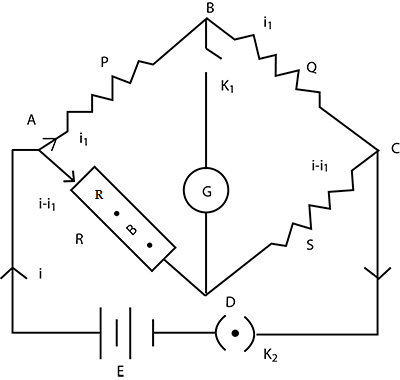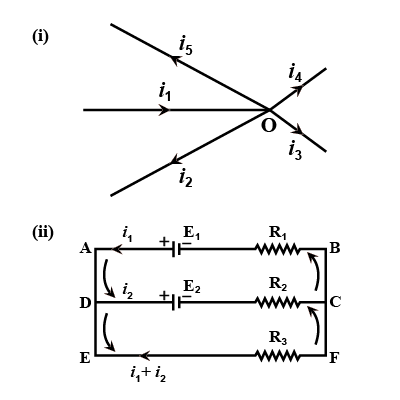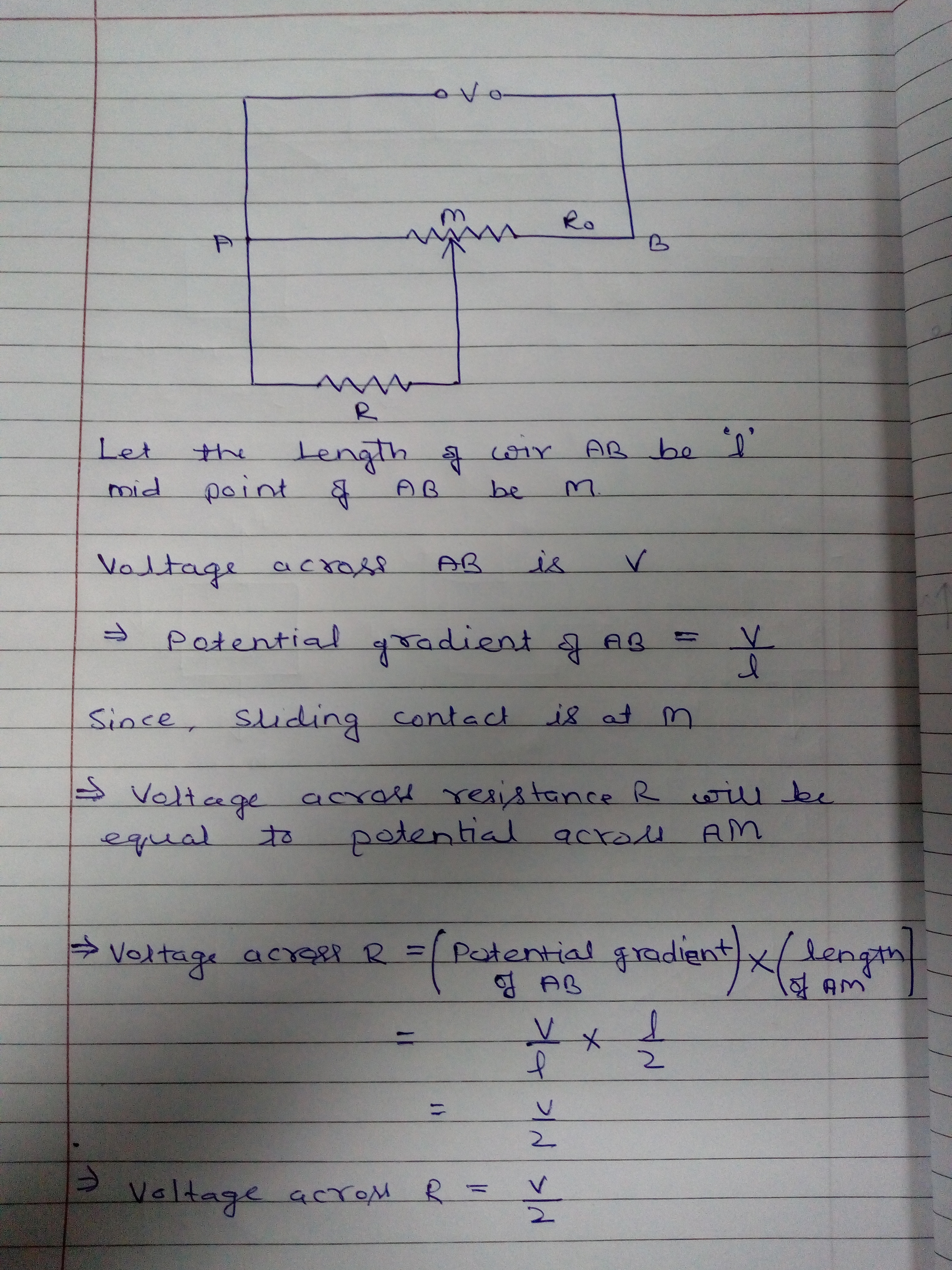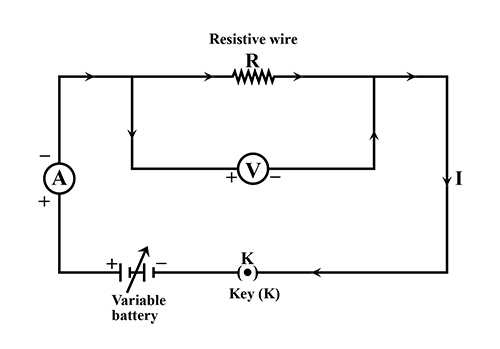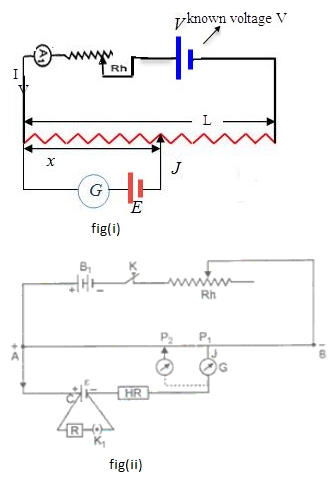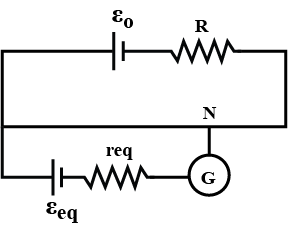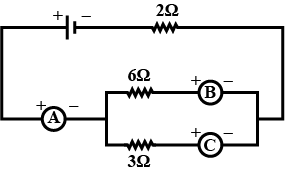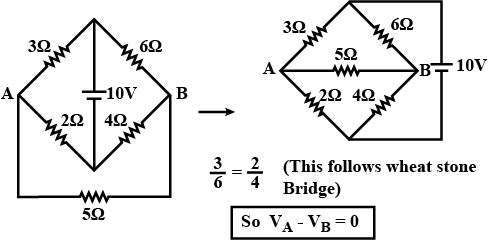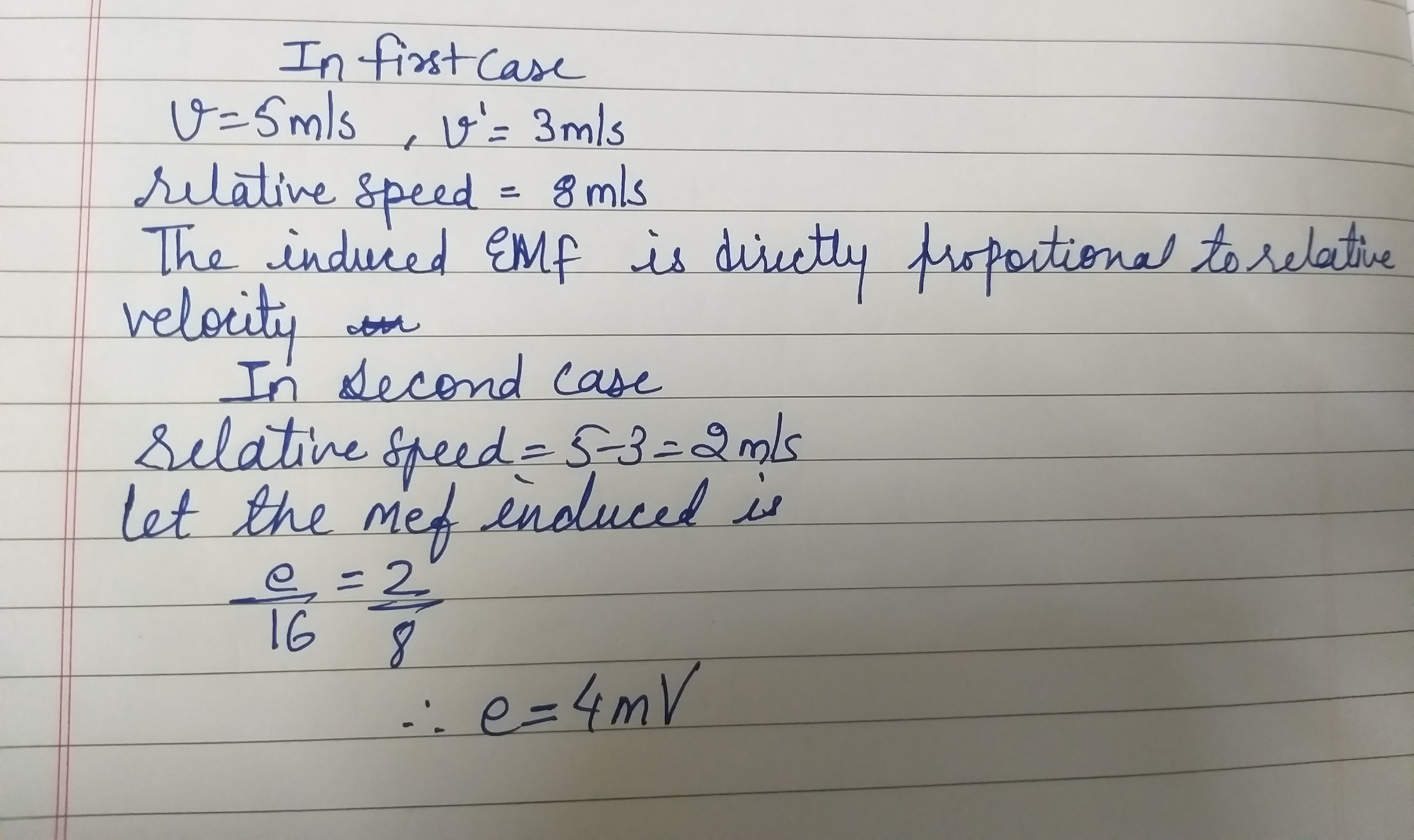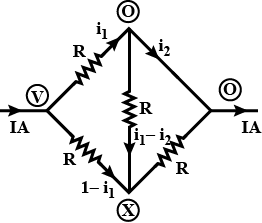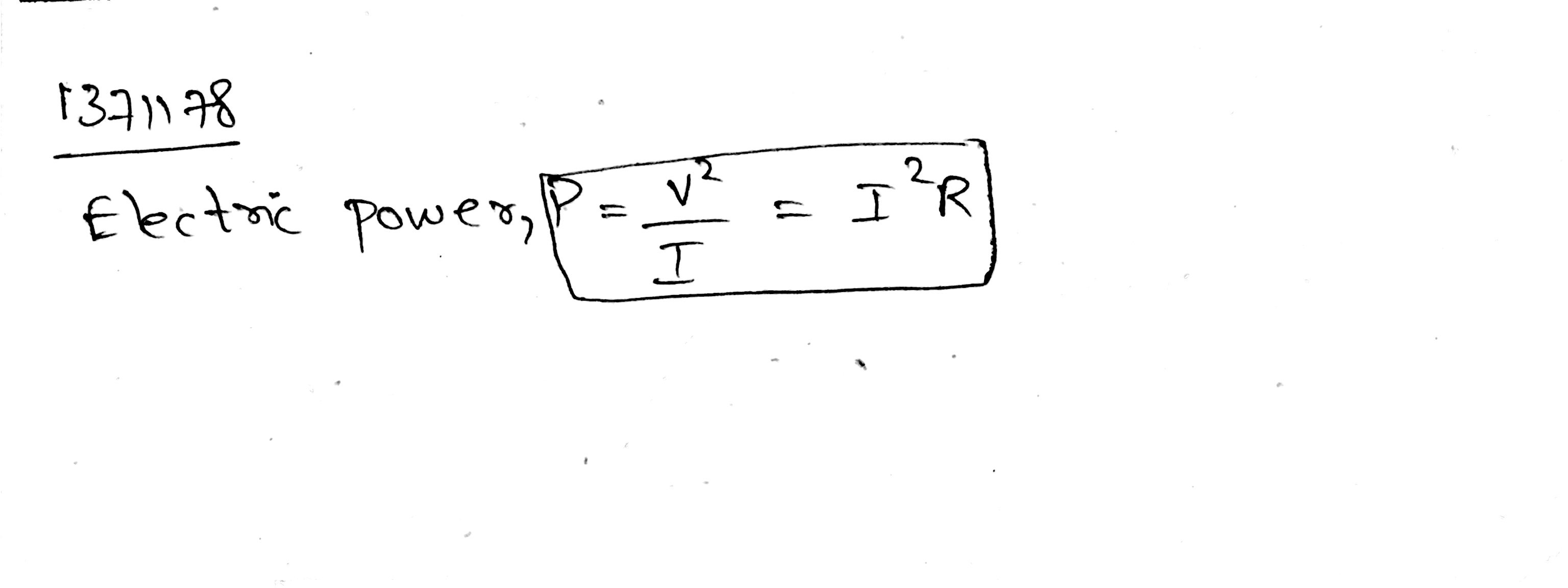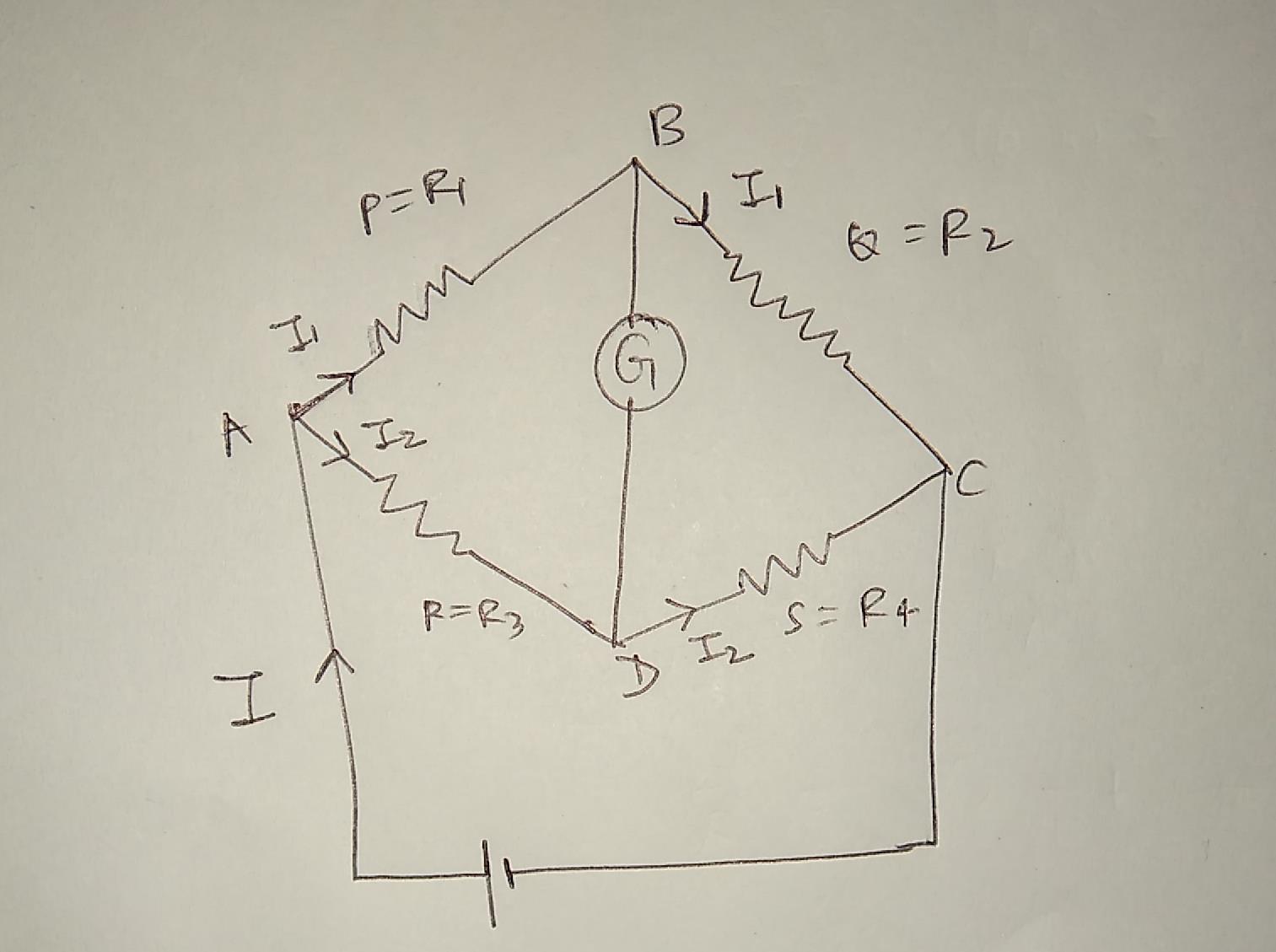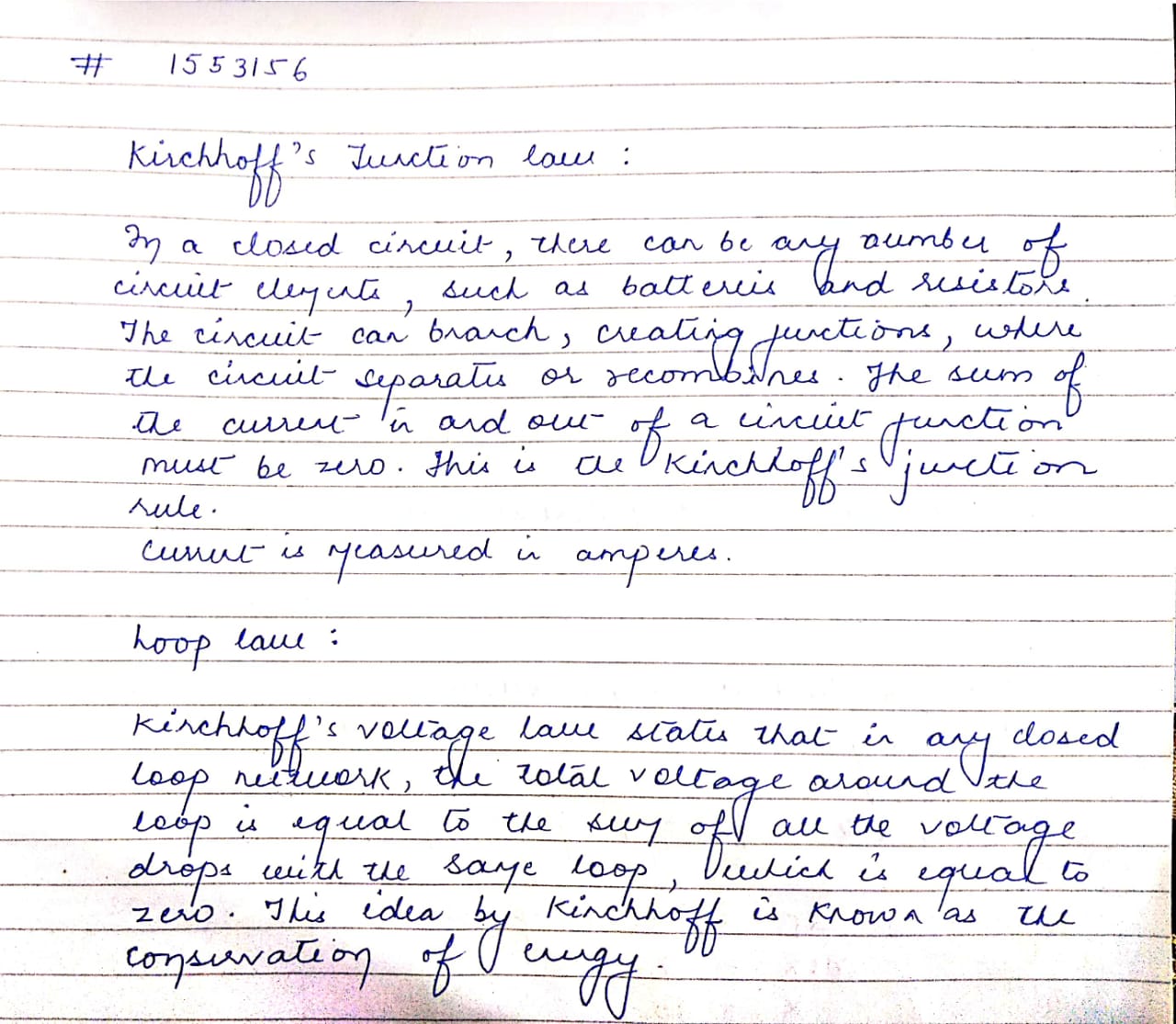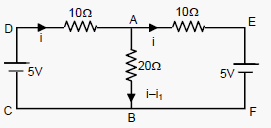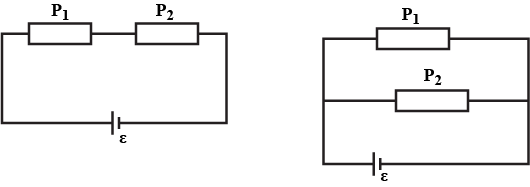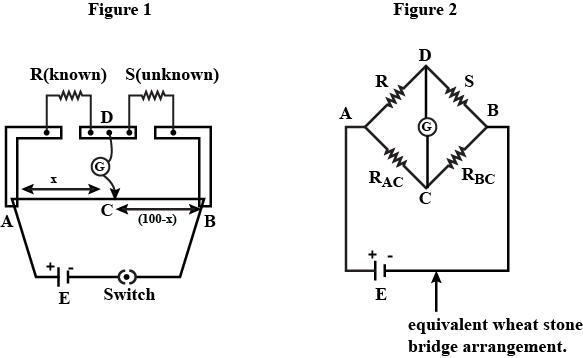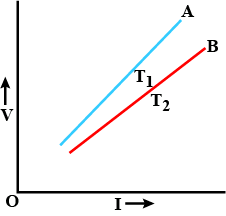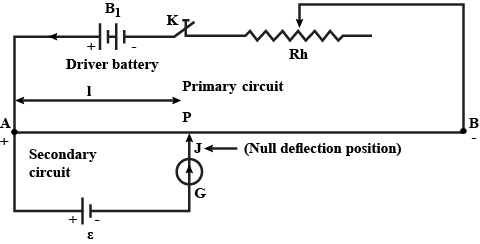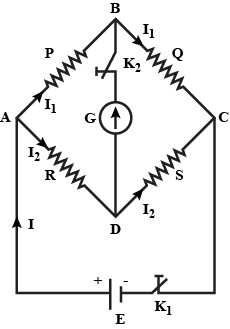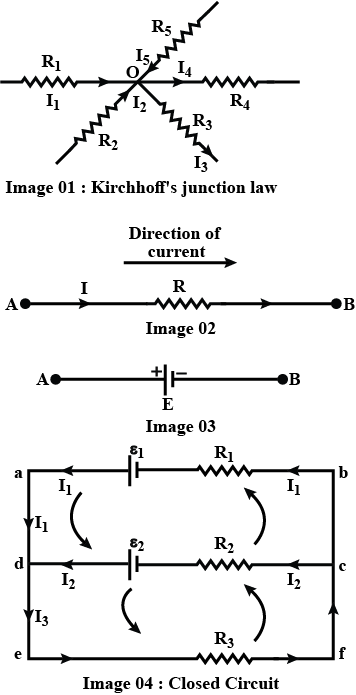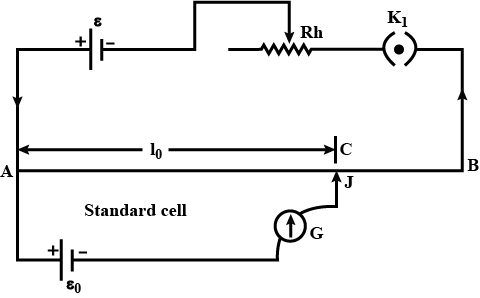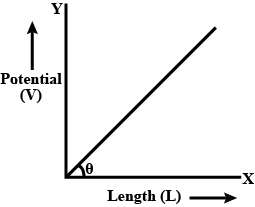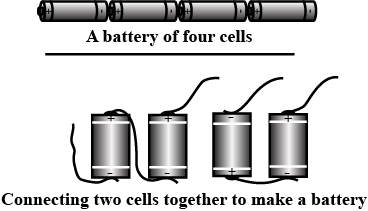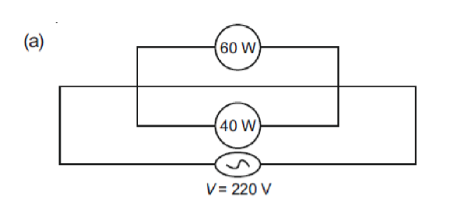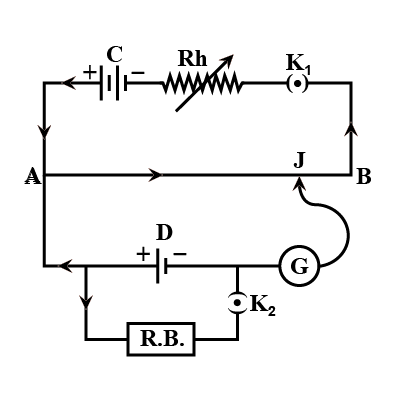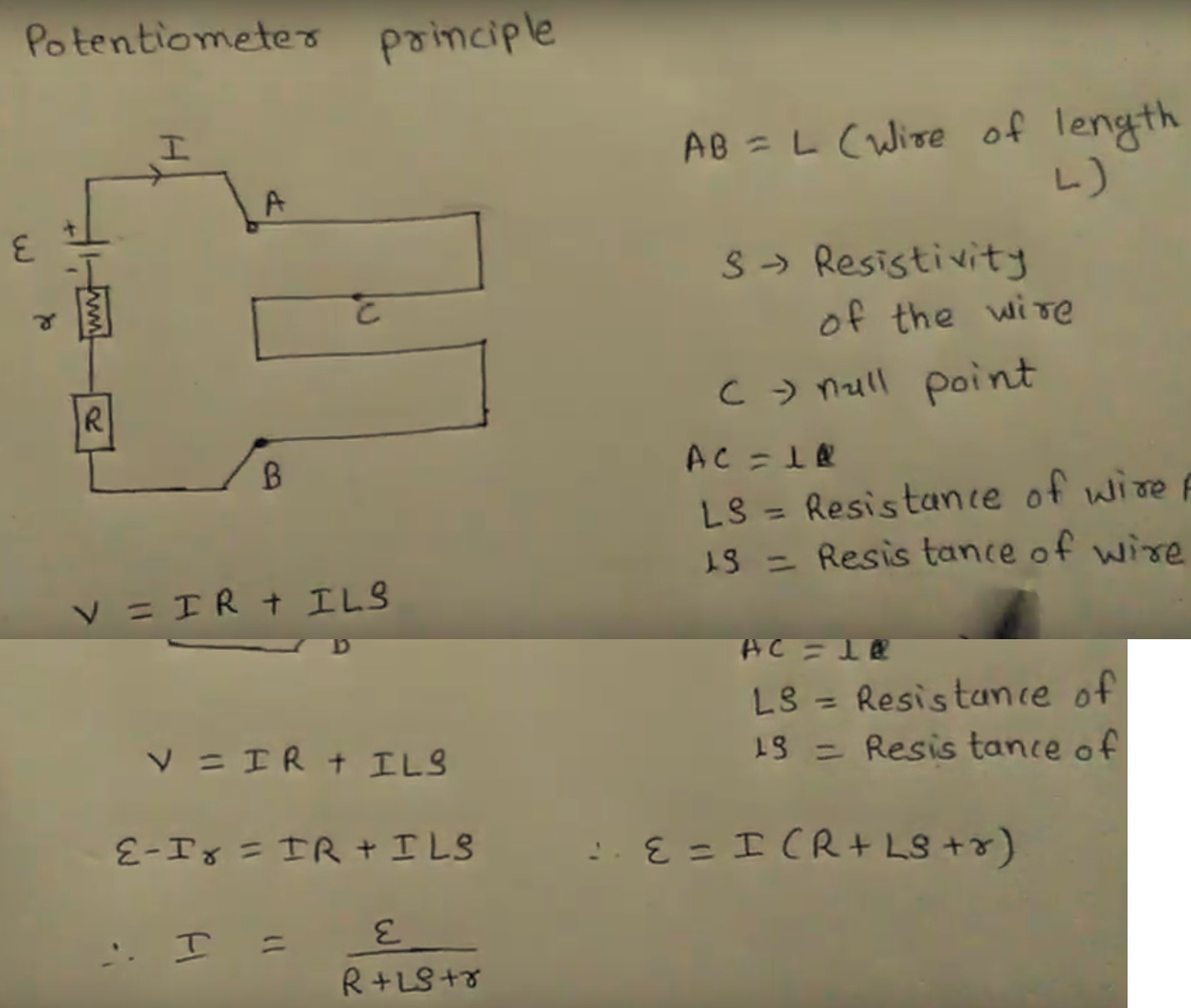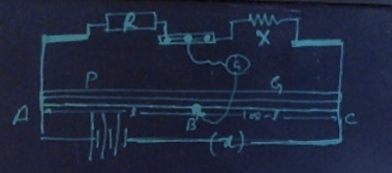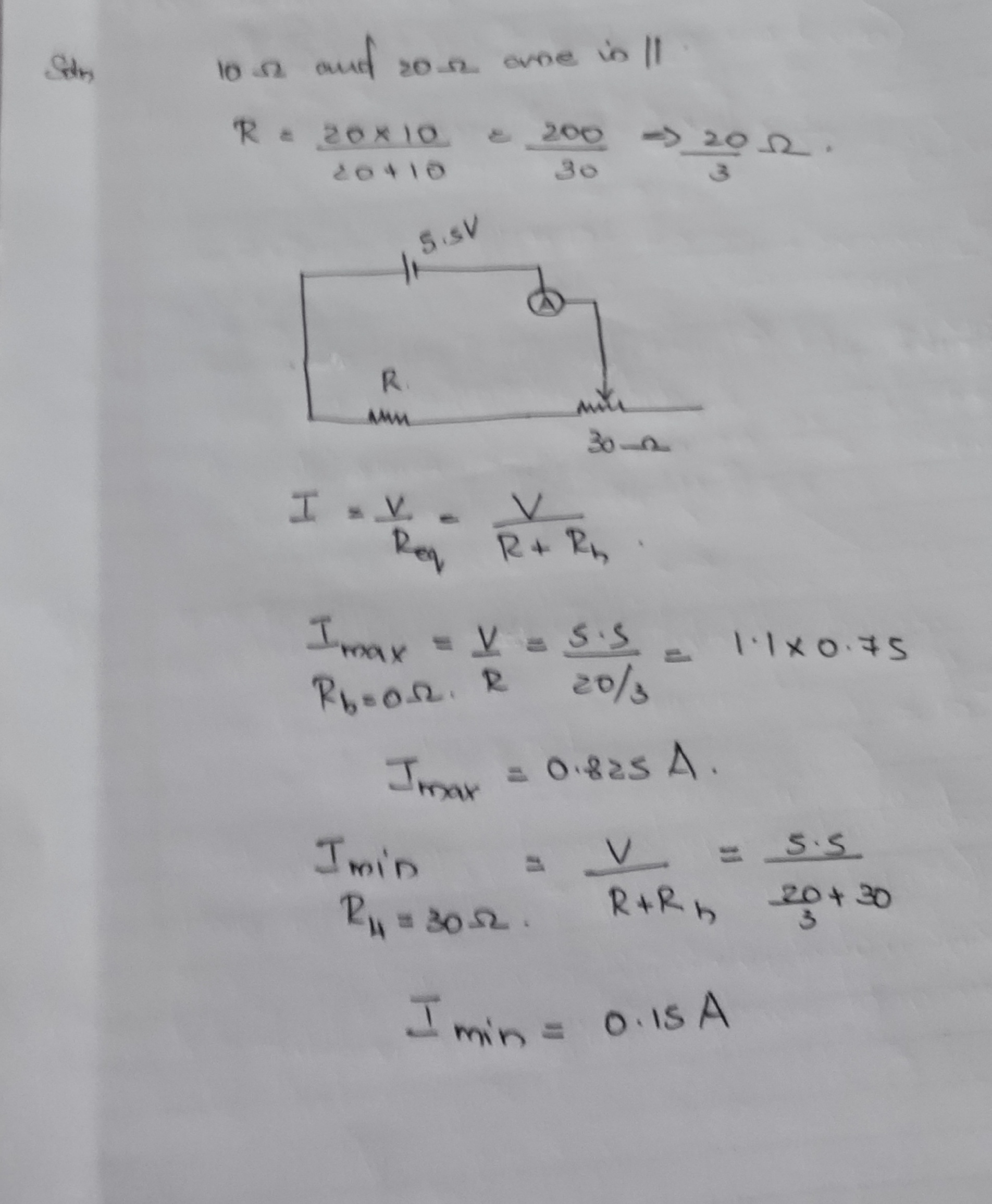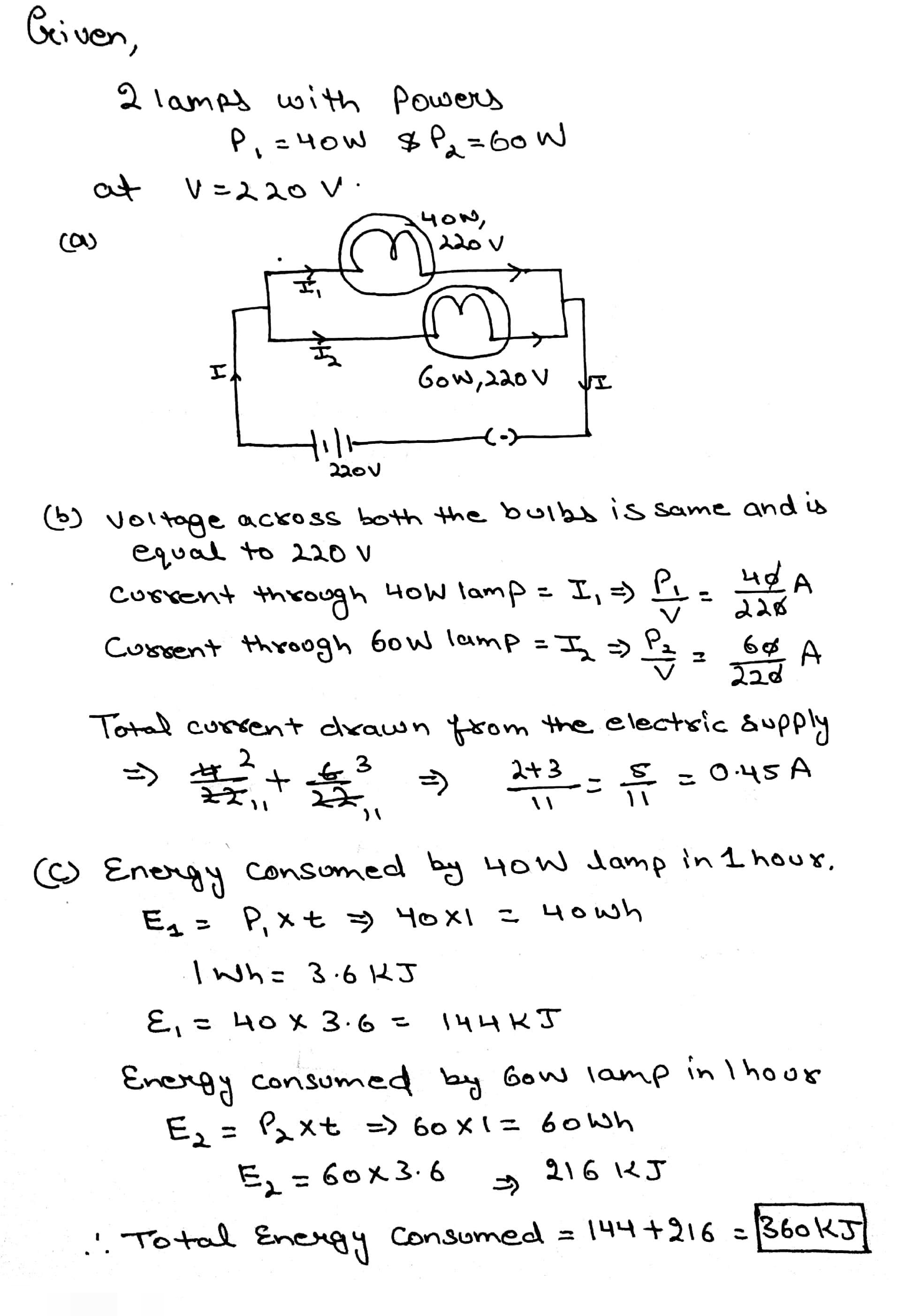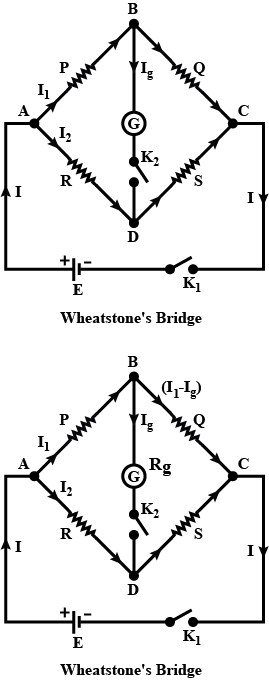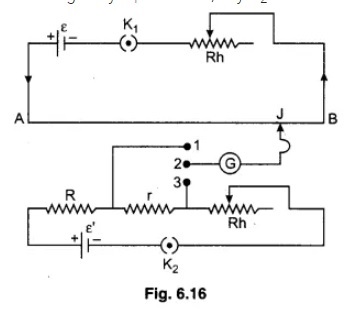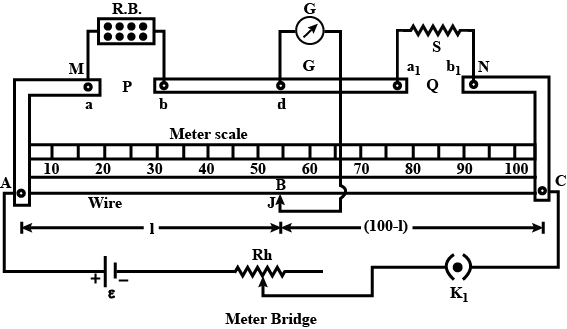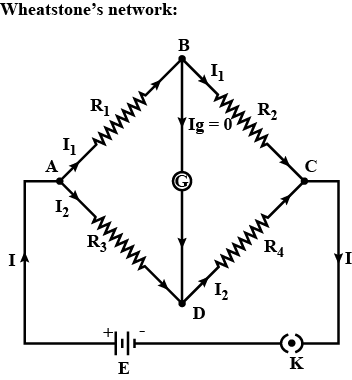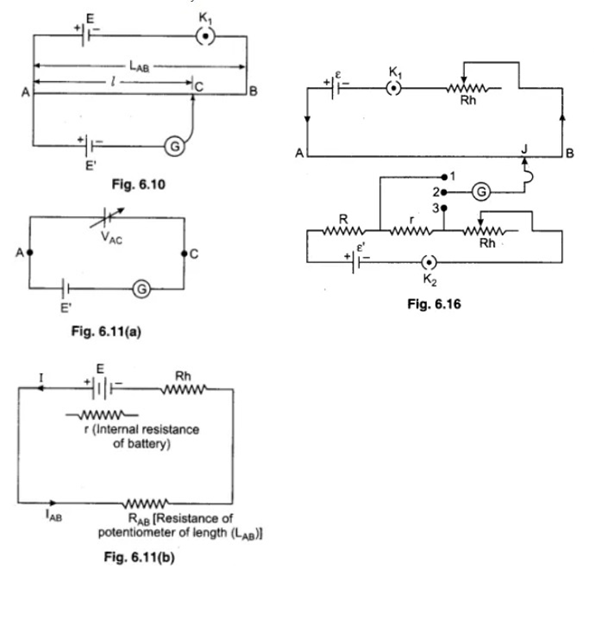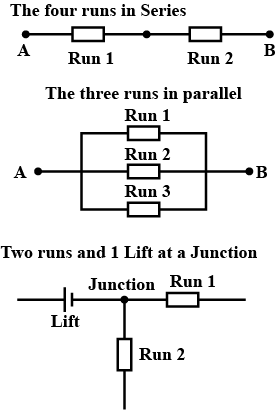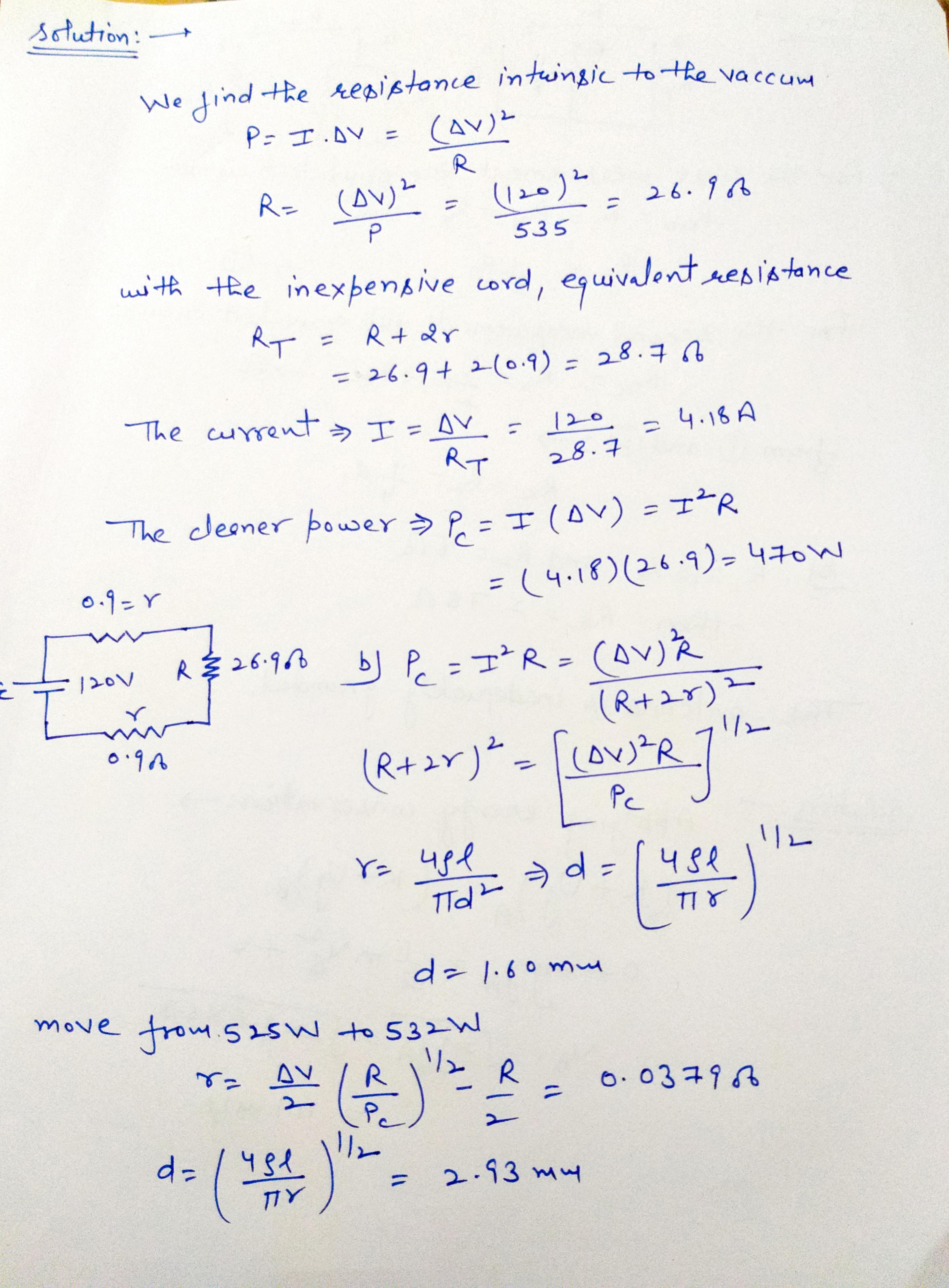Current Electricity - Class 12 Medical Physics - Extra Questions
A cell of emf 'E' and internal resistance r is connected across a variable resistor 'R'. Plot a graph showing variation of terminal voltage 'V' of the cell versus the current 'I'. Using the plot, show how the emf of the cell and its internal resistance can be determined.
A voltage V0 is applied to a potentiometer whose sliding contact is exactly in the middle. A voltmeter V is connected between the sliding contact and one fixed end of the potentiometer. It is assumed that the resistance of the voltmeter is not very high in comparison to the resistance of the potentiometer wire. What voltage will the voltmeter show : higher than, less than, or equal to V0/2?
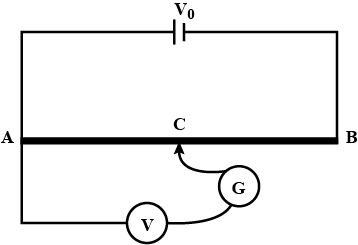
Primary circuit of potentio meter is as shown in the diagram find potential gradient.
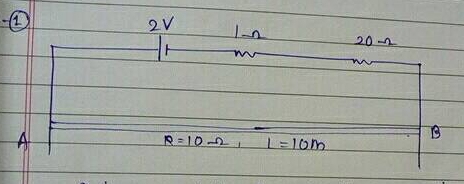
Two cell of emf 6V and 4V having internal resistance 3Ω and 2Ω respectively are connected in parallel so all to send a current through extend resistance of 8Ω in the same direction. Find the current through the cells and the potential difference across 8Ω Resistor.
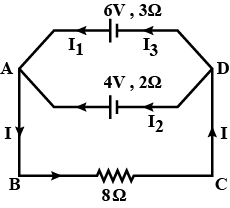
A potentiometer wire has an length 4 m and resistance 4Ω. What resistance must be connected in series with the wire and an accumulator of e.m.f. 2V, so as to get a potential gradient of 10−3 V/cm on the wire?
A potential difference of 100V is applied across a resistor of resistance 50Ω for 6 minutes and 58 seconds. Find the heat produced in 1) joule 2) calorie
What should be the resistance of the shunt used? The potentiometer wire AB shown in figure (32-E26) is 40 cm long. Where should the free end of the galvanometer be connected on AB so that the galvanometer may show zero deflection?
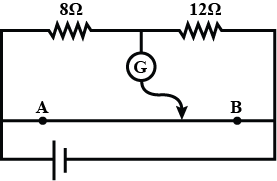
Derive the condition of balance for Wheatstone bridge.
In the figure shown below the maximum possible unknown resistance (X) that can be measured by the post office box are Xmax is given by R×105Ω then R is (given that in this experiment we can take out only one plug from arm AB and only one plug from arm BC but from arm AD we can take out many plugs)

A block in the shape of a rectangular solid has a cross-sectional area of 3.50cm2 across its width, a front-to-rear length of 15.8 cm, and a resistance of 935Ω. The block’s material contains 5.33×1022 conduction electrons/m3 . A potential difference of 35.8 V is maintained between its front and rear faces. (a) What is the current in the block? (b) If the current density is uniform, what is its magnitude? What are (c) the drift velocity of the conduction electrons and (d) the magnitude of the electric field in the block?
Why are fairy decorative lights always connected in parallel ?
What do you understand by electric energy?
Write the condition of the balanced state of the Wheatstone bridge.
Describe the principle and working of a meterbridge
Give reasons:
(i) The wires in the coil of resistance box are turned twice.
(ii) In Wheatstone bridge, initially a cell key and later galvanometer is pressed.
Why should the current be not passed through potentiometer wire for a long time?
A steady current flows in a metallic conductor of the non-uniform cross-section. Which of these quantities is constant along the conductor: current, current density, electric field, drift speed?
What will be the effect on the position of zero deflection if only the current flowing through the potentiometer wire is increased?
On what factors does the potential gradient of the wire depend?
Why should not the jockey be slided along the potentiometer wire?
Define or describe a Potentiometer.
In Wheatstone's meter-bridge experiment, the null point is obtained in the middle one-third portion of the wire. Why is it recommended?
Are Kirchhoff's laws applicable to both AC and DC currents?
Is Ohms law universally applicable for all conducting elements? If not, give examples of elements that do not obey Ohms law.
In a house two 60 W electric bulbs are lighted for 4 hours, and three 100 W bulbs for 5 hours everyday. Calculate the electric energy consumed in 30 days.
Give statements of Kirchhoff's junction and loop laws. Find out the balance condition of Wheatstone's bridge with the help of these laws.
Conceptual Questions
How does the resistance for copper and for silicon change with temperature? Why are the behaviors of these two materials different?
What do you mean by a potential difference of 1 volt?
Compare emf and potential difference.
Write two differences between emf and potential difference (pd).
Kirchhoff's rules are very useful for analysis of electrical circuits. State Kirchhoff's junction rules.
How much energy will be spent in 15 minutes in a 5 kilowatt electric heater?
What will be the effect of change in the length and thickness of the electrical wire in the experiment of electric current, potential difference and electric resistance?
Find the value of current I in given circuit.
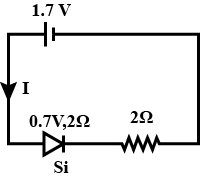
Figure shows four cells fixed on a board. Draw lines to indicate how you will connect their terminals with wires to make a battery of four cells.
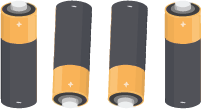
Define the term
dielectric constant. Give its S.I.unit.
A copper coil has a resistance of 2.43 Ω at 50oC. Find its resistance at 60oC. The resistance temperature coefficient of copper is 0.0043 per oC at 0oC.
A combination of two or more cells is called a _________.
At room temperature, 27∘C, the resistance of a heating element is 100Ω. What is the temperature(in ∘C) of the element if the resistance is found to be 117Ω? Given that the temperature coefficient of the material of the resistor is 1.70×10−4C−1.
For determination of resistance of a coil, which of two methods is better Ohm's Law method or metre bridge method ?
When is the Wheatstone's bridge said to be most sensitive?
Can we measure a resistance of the order of 0.160Ω using a Wheatstone's bridge? Support your answer with reasoning?
State the underlying principle of a potentiometer.
A combination of a group of cells joined in series is called a _______.
What do you mean by potential gradient?
In a potentiometer arrangement, a cell of emf 1.25 V gives a balance point at 35.0 cm length of the wire. If the cell is replaced by another cell and the balance point shifts to 63.0 cm, what is the emf of the second cell?
Use Kirchhoff's rule to obtain conditions for the balance condition in a Wheatstone bridge.
What is a potential meter explain its principal
(a)Explain how it can be used to compare the emf of two cells
(b)Explain how it can be used to determine the internal resistance of a cells.
Fig shown a simple potentiometer circuit for measuring a small e.m.f produced buy a thermocouple. The meter wire PQ has a resistance of 5 Ω. If a balance point is obtained 0.6 m along PQ when measuring an e.m.f of 6 mV., what is the value of resistance R?

An electric heater and a motor of 750 W and 1kW are used for domestic purpose for 2 hours and 1 1/2 hours per day in the month of January respectively. Calculate the cost of energy used if unit costs 5.50.
Networks of nine conductors connects six points A, B, C, D, E and F as shown
in figure. The figure denoted resistances in ohms. Find the equivalent resistance between A and D.
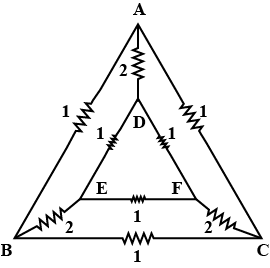
An electric heater of resistance 8Ω draws 15A from the service mains in 2 hrs.Calculate the rate at which heat is developed in the heater.
The voltmeter shown in figure, reads 18 V across the 50Ω resistor. Find the resistance of the voltmeter.
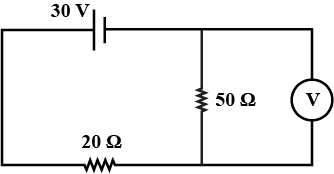
Primary circuit of potentio meter is as shown in the diagram find current in primary.
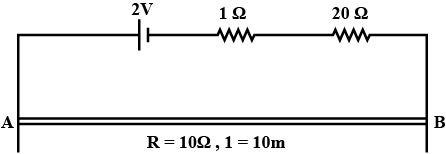
In the figure, take the potential at B to be zero.
(a) What are the potentials at the point A and C? (b) At which point D of the wire AB, the potential is equal to the potential at C? (c) If the points C and D are connected by a wire, what will be the current through it? (d) If the 4V battery is replaced by a 7.5 V battery, what would be the answers of parts (a) and (b)?
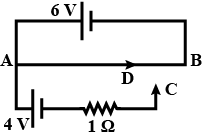
Find the radius of the wire of length 25 m needed to prepare a coil of resistence 25 Ω (Resistivity of material of wire is 3.142×10−7Ωm)
What is the principle of metre-bridge ?
State KCL and explain its sign conventions
Two bulbs of 40W each are lighted for eight hours daily. Find the cost of electrical energy consumed by them in one week at Rs. 3 per unit.
In the potentiometer circuit suppose ε =12V, ℓ =1m
if the galvanometer current is zero when x=075m, (a) find the
potential difference V, (b) if v=emf of the battery, find its
internal resistance.
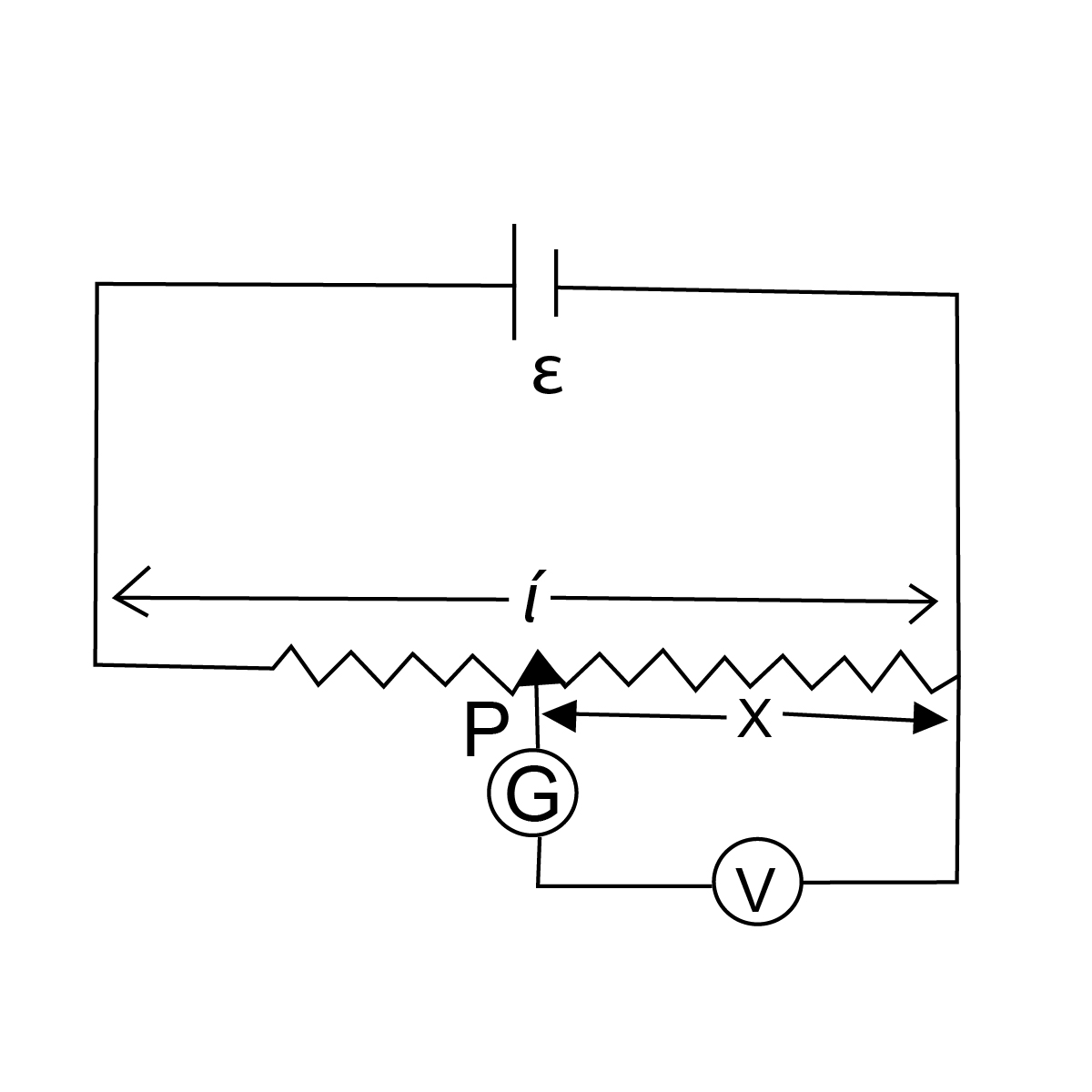
In the figure a long uniform potentiometer wire AB is having a constant potential gradient along its length. The null points for the two primary cells of emfs ε1 and ε2 connected in the manner shown are obtained at a distance of 120cm and 300cm from the end A. Find (i) ε1/ε2 and (ii) position of null point for the cell ε1.
How is the sensitivity of a potentiometer increased?
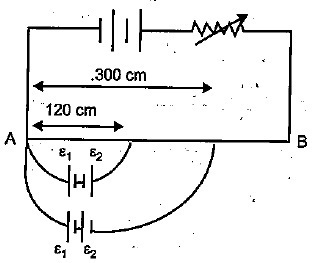
State Kirchhoff's rules. Explain briefly how these rules are justified.
A potentiometer wire of length 1.0 m has a resistance of 15 Ω. It is connected to a 5V battery in series with a resistance of 5 Ω. Determine the emf of the primary cell which gives a balance point at 60 cm.
Write the difference between potential difference and emf.
Explain Krichhoff's laws with examples.
State Ohm's law. Suggest an experiment to verify it and explain the procedure.
In a meter bridge, the balance point is found at a distance l1 with resistances R and S as shown in the figure.
An unknown resistance X is now connected in parallel to the resistance S and the balance point is found at a distance l2. Obtain a formula for X in terms of l1,l2 and S.
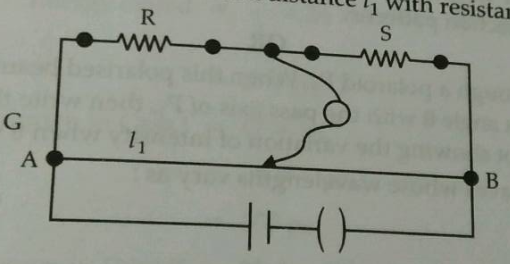
Write Kirchhoff's first rule (law of junction). Drawing a circuit diagram of Wheatstone bridge, derive condition for zero deflection in the bridge.
(a) Define potential gradient.
(b) Write Kirchhoff's junction rule.
In the given diagram write the value of current I.

Write Kirchhoff's first rule. A battery of 10 V and negligible internal resistance is connected to the diagonally opposite corners of a cubical network consisting of 12 resistors each of resistance 2Ω. Determine the equivalent resistance of the network.
Obtain the condition for bridge balance in Wheatstone's bridge.
Draw. Wheatstone's bridge circuit and write the condition for its balance.
State the working principle of potentiometer. Explain with the help of circuit diagram how the emf of two primary cells are compared by using the potentiometer.
Write the principle of working of a meter bridge.
Derive the balancing condition of a Wheatstone bridge.
Derive the condition for balance of a Wheatstone's bridge using Kirchhoff's rules.
State Kirchhoff's law for an electrical network. Using these laws, deduce the condition for balance in a Wheatstone bridge.
State and explain Kirchhoff's Laws in the current electricity.
The figure is a part of a closed circuit. Find the currents i1,i2 and i3.

A resistance of R Ω draws current from a potentiometer. The potentiometer wire, AB, has a total resistance of R0 Ω. A voltage V is supplied to the potentiometer. Derive an expression for the voltage across R when the sliding contact is in the middle of the potentiometer wire.
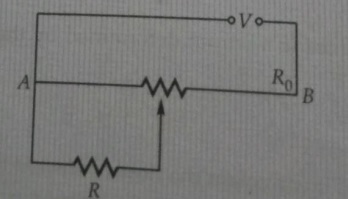
Draw a labelled diagram of experiment explaining Ohm's Law.
Veena's car radio will run from a 12 V car battery that produces a current of 0.20 A even when the car engine is turned off. The car battery will not longer operate when it has lost 1.2×106J of energy. If Veena gets out of the car, leaving the radio on by mistake, how long will it take for the car battery to go completely dead, i.e., lose all energy?
How will the position of balance point in the potentiometer will be affected if, (I) current in the potentiometer be increased, (ii) length of the potentiometer wire be doubles?
On which conservation principle is Kirchoff's Second Law of electrical networks based?
The resistance of a conductor at 20oC is 3.15 ohm and at 100 oC is 3.75ohm. Determine the temperature co-efficient of resistance of the conductor. What will be the resistance of the conductor at 0 oC?
Write down the principle of potentiometer. Why is it called an ideal voltmeter?
The potentiometer wire AB shown in the figure is 40cm long. Where should the free end of the galvanometer be connected on AB so that the galvanometer may show zero deflection?
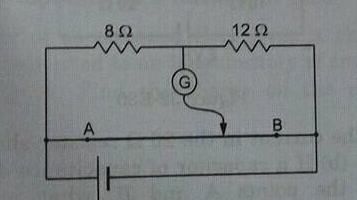
A resistance of R draws the current form of the potentiometer. The potentiometer wire, AB, has a total resistance of R0. A voltage V is supplied to the perpendicular. Derive an expression for the voltage across R when the sliding contact is in the middle of potentiometer wire.
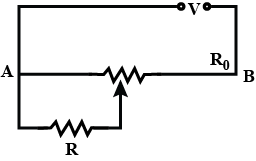
State Kirchoff's current law and also give the sign convention for current.
In a potentiometer experiment, balancing length is found to be 120cm for a cell E1 of emf 2V. What will be the balancing length for another cell E2 of emf 1.5V? (No other changes are made in the experiment.)
Describe the construction and working of a potentiometer. Explain, drawing circuit diagram, how emfs of two cells can be compared with its help?
Derive the relation between the resistances of the arms of a Wheatstone bridge in its balance condition. Write its two applications.
The length of potentiometer wire is 10m and is connected in series with an accumulator. The e.m.f. of a cell balances against 250 cm length of wire. If the length of potentiometer wire is increased by 1m, calculate the new balancing length of wire.
Why is Wheatstone bridge (Metre Bridge) method not suitable for measurement of very low and very high resistance?
A battery of emf E0 = 12V is connected across a 4m long uniform wire having resistance 4Ωm. The cells of small emfs ε1 = 2V and ε2 = 4V having internal resistance 2Ω and 6Ω respectively, are connected as shown in the figure. If galvanometer shows no deflection at the point N, find the distance of point N from the point A.

The length of potentiometer wire is 10 m and is connected in series with an accumulator. The e.m.f. of a cell balances against 250 cm length of wire. If the length of potentiometer wire is increased by 1m, calculate the new balancing length of wire.
Why can one ignore quantisation of electric charge when dealing with macroscopic i.e., large scale charges ?
State the working principle of potentiometer explain with the help of circuit diagram. How the emf of two primary cells are compared by using the potentiometer.
Find the internal resistance in the given circuit.
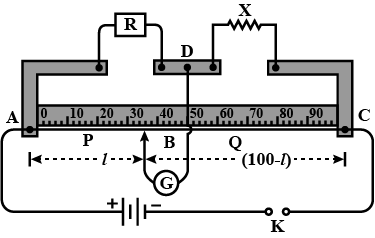
State Kirchoff's rules. Use these rules to find the values of current I1,I2,I3 in the circuit diagram given
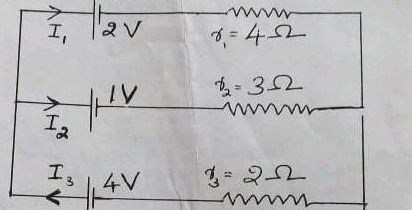
Draw a circuit diagram of an electric circuit containing a cell, a key, an ammeter, a resistor of 4Ω in series with a combination of two resistors ( 8Ω each ) in parallel and a voltmeter across parallel combination. Each of them dissipate maximum energy and canwithstand a maximum power of 16W without melting. Find the maximum current that can flow through the three resistors.
As shown in following circuit A,B and C are three ammeter. 0.5 A current is shown by ammeter B.
(a) Find the current passing through Ammeter A and C.
(b) Find total resistance of circuit.
(c) Find emf of the battery (Take resistance of each ammeter as zero.)
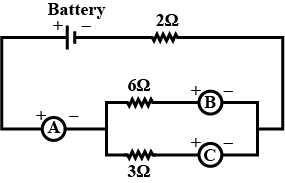
Two diametrically opposite points of a metal ring are connected to terminals of the left gap of meter bridge. In the right gap, resistance of 15Ω is introduced. If the null point is obtained at a distance of 40 cm from the left end, find resistance of the wire that is bent in the shape of the ring.
What's the difference between the electrostatic potential of the positive and negative end of an electric cell?
In the adjoint figure, Calculate VA − VB ?
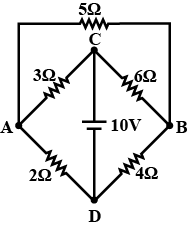
A charge q is placed at the centre of the line joining two equal charges Q. The system of the three charges will be in equilibrium if q is equal to?
What is potentimeter? Write its principle.
A coil and a magnet moves with their constant speed 5 m/sec. and 3 m/sec. respectively, towards each other, then induced emf in coil is 16 mV. If both are moves in same direction, find induced emf in coil?
State any two possible sources of errors in meter bridge experiment.
An electric fan runs from the 220 V mains. The current flowing through it is 0.5 A. At what rate is the electrical energy transformed by the fan? How much energy is transformed in 2 min?
What is the advantages of using thick metallic strips of join wires in a potentiometer?
State the two Kirchhoff's laws. Explain briefly, how these rules are justified?
Potentiometer wire length is 10m, having a total resistance of 10Ω. If a battery of emf 2 volts (of negligible internal resistance) and a rheostat are connected to it them the potential gradient is 20mV/m; find the resistance imparted through the rheostat
A battery having a steady voltage is connected to the ends of 10 m long potentiometer wire.The null point for a Leclaire cell is obtained at 750 cm.If the length of potentiometer wire is increased by 1 m,the new balancing length in metres will be:-
Find the current in each branch ?
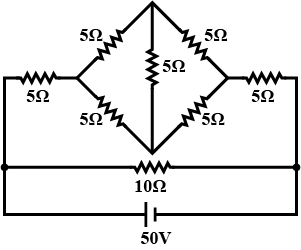
A battery of e.m.f. 15 V and internal resistance 2 Ω is connected to two resistors of resistances 4 Ω and 6 Ωjoined in series. Find the electrical energy spent per minute in 6 Ω resistor.
What is the current of I2?
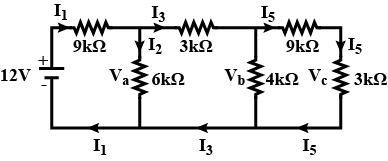
in a meter bridge, the balance point is found to be 40cm from one end (say end A). if a resistance of 10Ω is connected in series with R, a balance point is obtained 60cm from end A. What are the values of R and S (S is other resistance in series with R)?
If R=1Ω, the current in the branch x is :
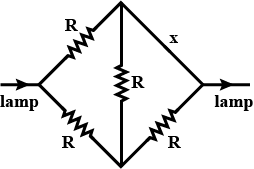
Which material is used for metere bridge wire and why ?
Electric power =V2..............
State Kirchoff's law for an electrical network. Using these laws deduce the condition for balance in a wheatstone bridge.
Three resistors 2Ω,4Ω and 5Ω are combined in parallel. What is the total resistance of the combination?
An electric fan runs from the 230V mains . The current flowing through it is 0.4A . At what rate electrical energy transferred by the fan?
A wire with an area of cross-section as 10mm2 has a resistance of 5Ω, when a potential difference across its ends is 25V. Calculate the drift velocity of electrons. Given the number density of electrons as 5×1020 electrons per cubic meter (e/m−3).
Write the statement of Kirchhoff's Junction law and loop law.
What do you understand by electricity at rest?
(a) Find the current in the 20Ω resistor shown in the figure.
(b) If a capacitor of capacitance 4μF is joined between the points A and B, what would be the electrostatic energy stored in it in steady-state ?

Two metallic wires P1 and P2 of the same material and same length but different cross - sectional areas A1 and A2 are joined together and then connected to a source of emf. find the ratio of the drift. Velocities of free electrons in the wires P1 and P2 if the wires are connected (i) in series, and (ii) in parallel.
Draw the circuit diagram of a meter bridge to explain how it is based on Wheatstone bridge.
The potential difference applied across a given resistance is altered so that heat produced per second increases by a factor of 16.By what factor does the applied pd change?
A current of 1.0A exists in a copper wire of cross-section 1.0mm2. Assuming one free electron per atom calculate the drift speed of the free electrons in the wire. The density of copper is 9000kgm−3.
Name a device which helps to maintain potential difference across a conductor (say a , bulb)
If a potential difference of 10V causes a current of 2A to flow for 1 minute , how much energy is transferred ?
(a) Name a device that helps to measure the potential difference across a conductor.
(b) How much energy is transferred by a 12V power supply to each coulomb of charge which it moves around a circuit ?
(a) How does the resistance of a pure metal change if its temperature decreases ?
(b) How does the presence of impurities in a metal affect its resistance ?
An electric lamp is marked as 26 W,220 V. It is used for 10 hours daily. Calculate energy consumed in unit of kWh per day.
The current through the battery and resistors 1 and 2 in
Figure(a) is 2.00 A. Energy is transferred from the current to
thermal energy Eth in both resistors. Curves 1 and 2 in Figure(b) give that thermal energy Eth for resistors 1 and 2, respectively, as
a function of time t. The vertical scale is set by Eth,s=40.0mJ,
and the horizontal scale are set by ts=5.00s. What is the power of
the battery?
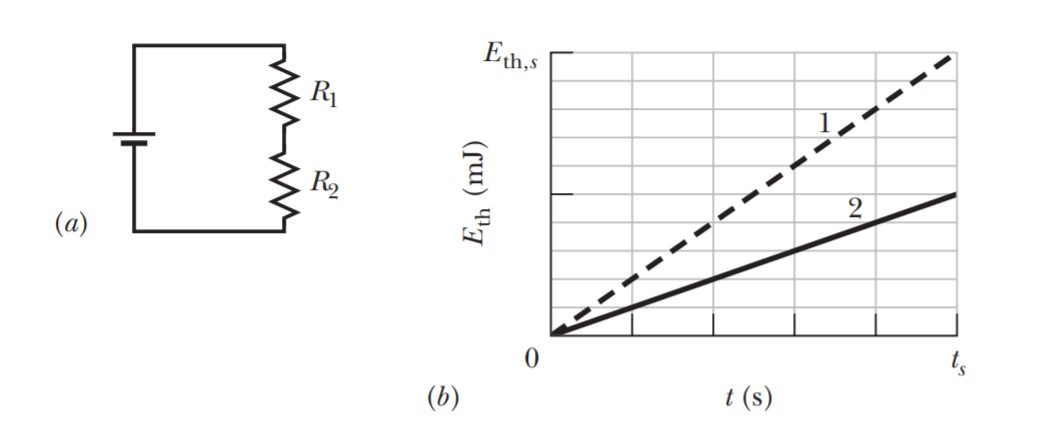
A 5.0 A current is set up in a circuit for 6.0 min by a rechargeable battery with a 6.0 V emf. By how much is the chemical energy of the battery reduced?
How much electrical energy is transferred to thermal energy
in 2.00 h by the electrical resistance of 400Ω when the potential
applied across it is 90.0 V?
Fill in the following blanks with suitable words :
Resistance is measured in...........................The resistance of a wire increases as the length.......................; as the
temparature................; and as the cross - sectional area...............
Draw a V−I graph for a conductor at two different temperature. What conclusion do you draw from your graph for the variation of resistance of conductor with temperature?
In Figure, R1=6.00Ω,R2=18.0Ω, and the ideal battery has emf E=12.0V . What are the (a) size and (b) direction (left or right) of current i1? (c) How much energy is dissipated by all four resistors in 1.00 min?
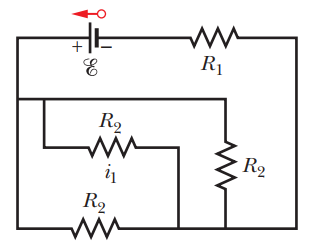
Figure shows a battery connected across a uniform resistor Ro. A sliding contact can move across the resistor from x=0cm at the left to x=10cm at the right. Moving the contact changes how much resistance is to the left of the contact and how much is to the right. Find the rate at which energy is dissipated in resistor R as a function of x. Plot the function for E=50V,R=2000Ω, and Ro=100Ω

Answer the following:
i) State the principle of working a potentiometer.
ii) Draw a circuit diagram to compare the emf of two primary cells.Write the formula used .How can the sensitivity of a potentiometer be increased?
iii) Write two possible causes for one sided deflection in the potentiometer experiment.
An electric bulb of power 60W is used for 6h per day. Calculate the 'units' of energy consumed in one day by the bulb.
Answer the following:
Why are the connections between the resistors in a meter bridge made of thick copper strips?
Figure shows a section of a circuit. The resistances are R1=2.0ΩR2=4.0Ω, and R3=6.0Ω, and the indicated current is i=6.0A. The electric potential difference between points A and B that connect the section to the rest of the circuit is VA−VB=78V. (a) Is the device represented by Box absorbing or providing energy to the circuit, and (b) at what rate ?
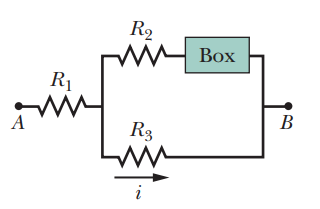
When is a Wheatstone's bridge most sensitive?
What do you understand by the term current ? State and define its S.I. unit.
Answer the following questions:
1) i) State the principle on which a potentiometer works.How can a given potentiometer be made more sensitive?
ii) In th egraph shown below for two potentiometers,state with reason which of the two potentiometer,A or B, is more sensitive.
2) Two metallic wires, P1 and P2 of the same material and same length but different cross-sectional area.A1 and A2 are joined together and connected to a source of emf.Find the ratio of the drift velocities of free electrons in the two wires when they are connected (i) in series and (ii) in parallel.
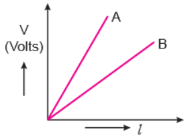
Draw the circuit diagram of potentiometer which can be used to determine the internal resistance (E) of a given cell of emf.Describe a method to find the internal resistance of a primary cell.
Explain with the help of circuit diagram how the value of unknown resistance can be determined using a Wheatstone Bridge. Find the formula used.
When the chemicals in the electric cell are used up, the electric cell stops producing electricity. The electric cell is then replaced with a new one. In case of rechargeable batteries (such as the type used in mobile phones. camera and inverters), they are used again and again. How?
If an electric iron of 1200\ W is used for 30 minutes every day, find electric energy consumed in the month of April.
How does one understand the temperature dependence of resistivity of a semiconductor ?
If an appliance of power P watt is used for time t hour. How much electrical energy is consumed in kWh ?
What is the advantage of using thick metallic strips to join wires in a potentiometer?
What are the advantages of the null-point method in a Wheatstone bridge? What additional measurements would be required to calculate R (unknown) by any other method?
Explain the meaning of the term e.m.f. of a cell.
Fill in the blanks:
The long line represents .......... and short line represents ........... terminal of electric battery's symbol.
Write the statement of Junction and Loop Law of Kirchhoff's.
Write the mathematical form of Kirchhoff's junction law.
How can the sensitivity of the potentiometer be increased?
Why the potential gradient of the wire of potentiometer is based on the temperature?
Why copper wire can not be used in potentiometer?
Why the cross-sectional area of the wire should be uniform in a potentiometer?
In a wall, there is a metallic framed window (120 cm \times 50cm) . The total resistance of a frame is 0.01 \Omega . Determine the charges flowing on opening the frame from 90^o . [If H=0.36 G]
What is standardisation of potentiometer? Write the process of it and draw the necessary diagram.
What is the sensitivity of potentiometer, how can it be increased?
Write down the energy changes in the following electrical devices with respect to their use.
| Device | Use | Energy change |
| ||
| ||
| ||
| ||
| ||
|
What may be factors affecting the induced emf ?
What are the advantages of connecting electrical devices in parallel with the battery instead of connecting them in series?
Energy is precious, especially electrical energy. Society must be convinced of the necessity of reducing the consumption of electrical energy. Prepare and propogate posters for this purpose.
What is battery? How do you arrange the cells in a battery?
Fill in the blanks:
The combination of two or more cells is called a ...............
A bulb of 60\,W in a classroom remains switched on for a long time from 9 am to 5 pm due to the negligence of students in the class.
Calculate in joule the electric energy consumed by the bulb ?
A bulb of 60\,W in a classroom remains switched on for a long time from 9 am to 5 pm due to the negligence of students in the class.
If similar negligence had happened in 3 classrooms, how many units of electric energy would have been wasted ?
Did the resistance increase or decrease when the temperature was increased?
Two lamps, one rated 60\ W at 220\ V and the other 40\ W at 220\ V, are connected in parallel to the electric supply at 220\ V.
(a) Draw a circuit diagram to show the connections
(b) Calculate the current drawn from the electric supply.
(c) Calculate the total energy consumed by the two lamps together when they operate for one hour.
Current of 4\ A flows through a 12\ V car headlight bulb for 10 minutes. How much energy transfer occurs during this time?
Figure shows a circuit containing a battery of electromotive force (e.m.f.) 12\,V and a heater of resistance 6.0\Omega.
State what is meant by electromotive force (e.m.f.).
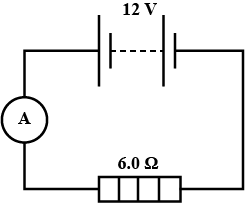
An electric bulb has marking 110 V, 100 W on it.
a. How much energy is used per second by the circuit?
b. What is the resistance of electric bulb?
How is the direction of electric current related to the direction of flow of electrons in a wire?
Figure shows a potentiometer circuit for comparison of two resistances. The balance point with a standard resistor R=10.0\Omega is found to be 58.3 cm, while that with the unknown resistance X is 68.5 cm. Determine the value of X. What might you do if you failed to find a balance point with the given cell of emf \epsilon?
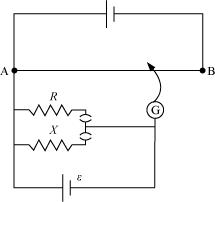
Describe the experiment to find internal resistance of a cell by Potentiometer under the following points.
(i) Labelled electric circuit diagram.
(ii) Derivation of formula
(iii) Observation table
(iv) Two precautions.
'n' cells, each of emf 'e' and internal resistance 'r' are joined in series to form a row. 'm' such rows are connected in parallel to form a battery of N = mn cells. This battery is connected to an external resistance 'R'
Show that current 'I' flowing through the external resistance 'R' is given by:
I = \dfrac {Ne}{mR + nr}
Deduce the principle of potentiometer with the help of necessary circuit diagram.
Derive the expression to find the unknown resistance in the balanced condition of wheastone bridge.
What is the effect of temperature on the resistance of a metal? The resistance of a platinum resistances thermometer at 0^oC temperature is 3.0\Omega and at 100^oC it is 3.75\Omega. Its resistance at an unknown temperature is 3.15\Omega. Find the value of the unknown temperature.
In the circuit shown in figure, { E }_{ 1 }=3V,{ E }_{ 2 }=2V,{ E }_{ 3 }=1V and { r }_{ 1 }={ r }_{ 2 }={ r }_{ 3 }=1ohm
(a) Find the potential difference between the points A and B and the currents through each branch.
(b) If {r}_{2} is short circuited and the point A is connected to point B through a resistance R, find the currents through {E}_{1},{E}_{2},{E}_{3} and the resistor R.
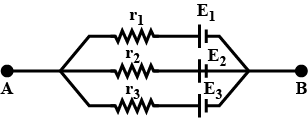
Define emf and internal resistance of a cell
Consider the potentiometer circuit arranged as in figure. The potentiometer wire is 600cm long. At what distance from the point A should the jockey touch the wire to get zero deflection in the galvanometer?
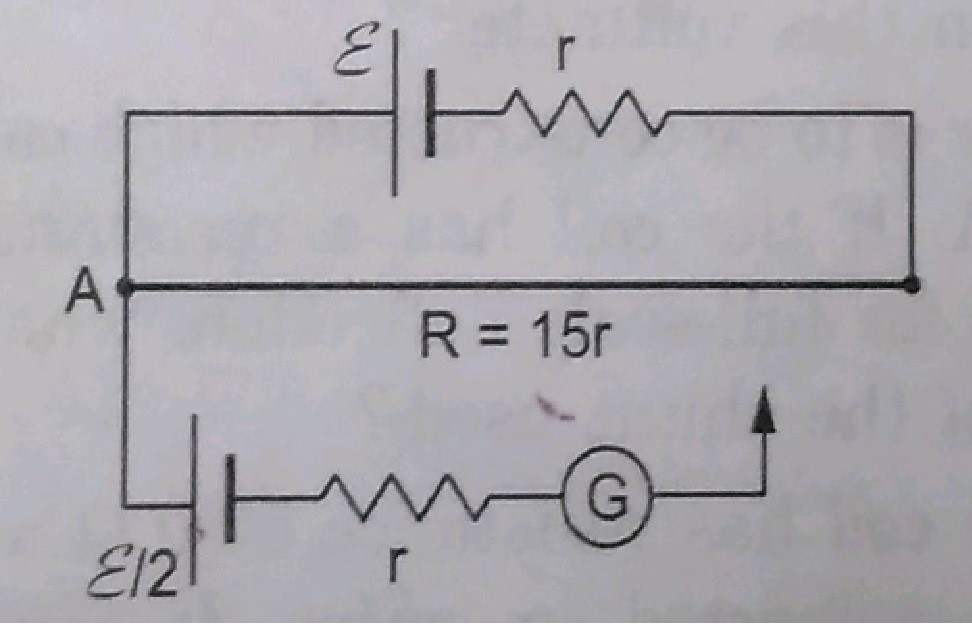
Explain the principle of potentiometer.
The resistance of an iron wire and a copper wire at 20^{o}C are 3.9\Omega and 4.1\Omega respectively. At what temperature will the resistance be equal ? Temperature coefficient of resistivity for iron is 5.0\times 10^{-3}K^{-1} and for copper it is 4.0\times 10^{-3}K^{-1}. Neglect any thermal expansion.
On what principle is Kirchhoff's current law based?
State the working principle of a potentiometer with the help of the circuit diagram, explain how a potentiometer is used to compare the emf's of the two primary cell obtain the required expression used for comparing the emf's.
Calculate the steady current through the 2\Omega resistor in the circuit shown in the figure.
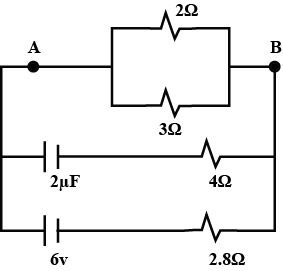
The resistance of the rheostat shown in figure is 30 \Omega. Neglecting the meter resistance, find the minimum and maximum currents through the ammeter as the rheostat is varied.
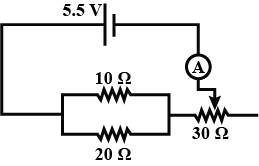
Define e.m.f. of a cell. How can you compare the emf of two cells using potentiometer?
Two lamps, one rated 40 W \,at \,220 V and the other 60 W \,at\, 220 V, are connected in parallel to the electric supply at 220 V.
(a) Draw a circuit diagram to show the connections.
(b) Calculate the current drawn from the electric supply.
(c) Calculate the total energy consumed by the two lamps together when they operate for one hour.
What is Wheatstone bridge? Deduce the balanced condition of it with the help of Kirchhoff's law.
Draw the necessary diagram for measuring small resistance by potentiometer?
Answer the following questions:
i) Using Kirchhoff's rules,calculate the current in the arm AC of the given circuit.
ii) On what principle does the meter bridge work? Why are the metal strips used in the bridge?
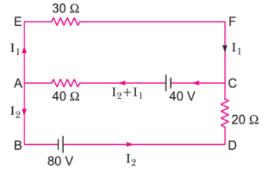
How much energy is given to each coulomb of charge passing through a 6 V battery?
What is the meter bridge? On which principle does it work? Explaining its construction obtain the expression for determining unknown resistance with the help of meter bridge. Given necessary diagram also.
Conceptual Questions
Use the atomic theory of matter to explain why the resistance of a material should increase as its temperature increases.
Observe and record the meter reading in your house for 10 consecutive days. Based on this, find out the average consumption per day. Find out methods to reduce consumption and record them. Present your findings in the Energy Club.
Explain electrical energy and derive its formula.
With the help of a labelled diagram, show that the balancing condition of a Wheatstone bridge is \frac{R_1}{R_2} = \frac{R_3}{R_4} where the terms have their usual meaning.
What is potentiometer? Explain its principle. Describe the method of determining a small resistance by potentiometer. Make necessary diagram also.
Conceptual Questions
A ski resort consists of a few chairlifts and several interconnected downhill runs on the side of a mountain, with a lodge at the bottom. The chairlifts are analogous to batteries, and the runs are analogous to resistors. Describe how two runs can be in series.Describe how three runs can be in parallel. Sketch a junction between one chairlift and two runs. State Kirchhoffs junction rule for ski resorts. One of the skiers happens to be carrying a skydivers altimeter.She never takes the same set of chairlifts and runs twice, but keeps passing you at the fixed location where you are working. State Kirchhoffs loop rule for ski resorts.
Additional Problems(69)
A young man owns a canister vacuum cleaner marked "535 \,W [at] 120 \,V" and a Volkswagen Beetle, which he wishes to clean. He parks the car in his apartment parking lot and uses an inexpensive extension cord 15.0 \,m long to plug in the vacuum cleaner. You may assume the cleaner has constant resistance.
(a) If the resistance of each of the two conductors in the extension cord is 0.900 \,\Omega, what is the actual power delivered to the cleaner?
(b) If instead the power is to beat least 525 \,W, what must be the diameter of each of two identical copper conductors in the cord he buys?
(c) Repeat part (b) assuming the power is to be at least 532 \,W.
Class 12 Medical Physics Extra Questions
- Alternating Current Extra Questions
- Atoms Extra Questions
- Current Electricity Extra Questions
- Dual Nature Of Radiation And Matter Extra Questions
- Electric Charges And Fields Extra Questions
- Electromagnetic Induction Extra Questions
- Electromagnetic Waves Extra Questions
- Electrostatic Potential And Capacitance Extra Questions
- Magnetism And Matter Extra Questions
- Moving Charges And Magnetism Extra Questions
- Nuclei Extra Questions
- Ray Optics And Optical Instruments Extra Questions
- Semiconductor Electronics: Materials, Devices And Simple Circuits Extra Questions
- Wave Optics Extra Questions
